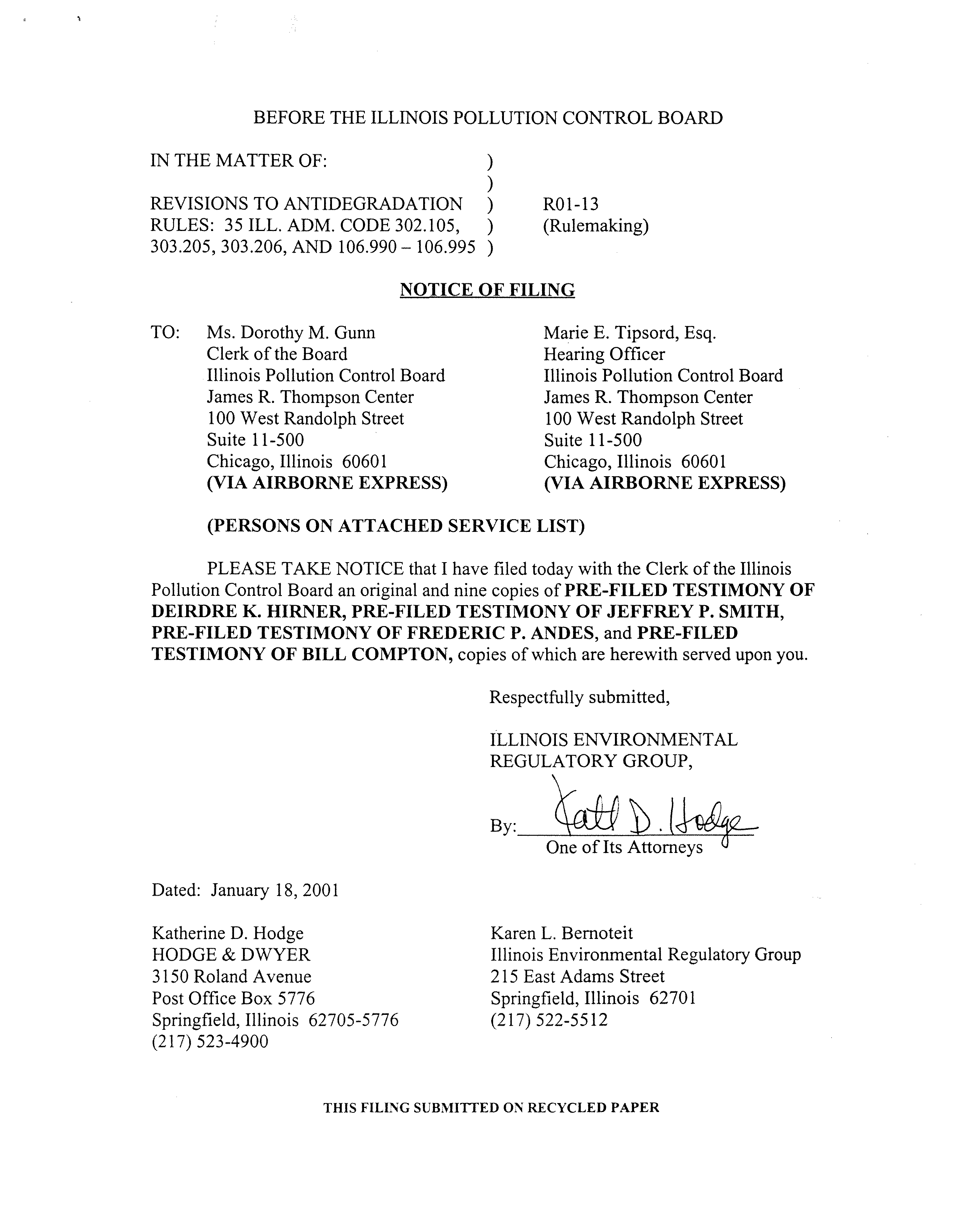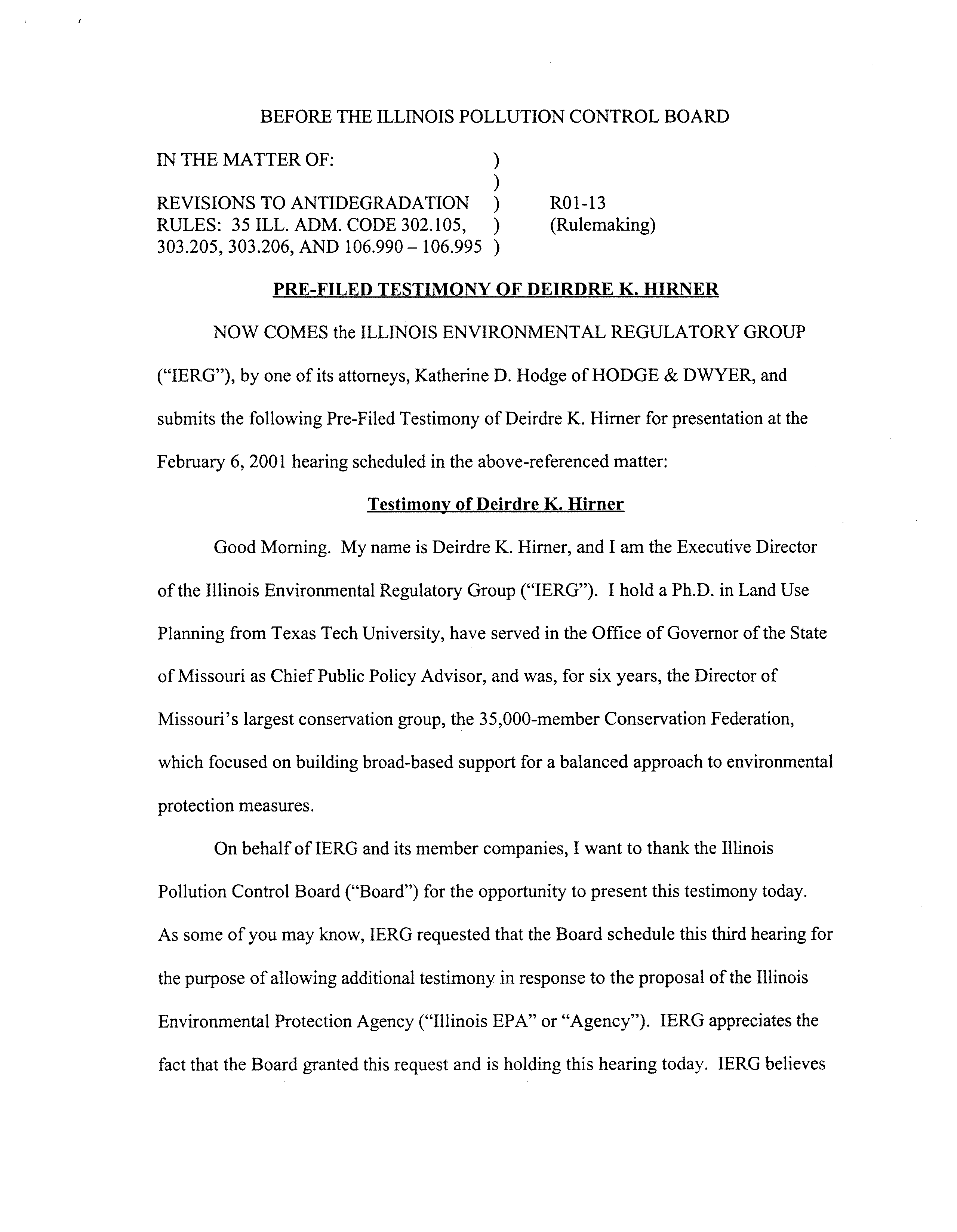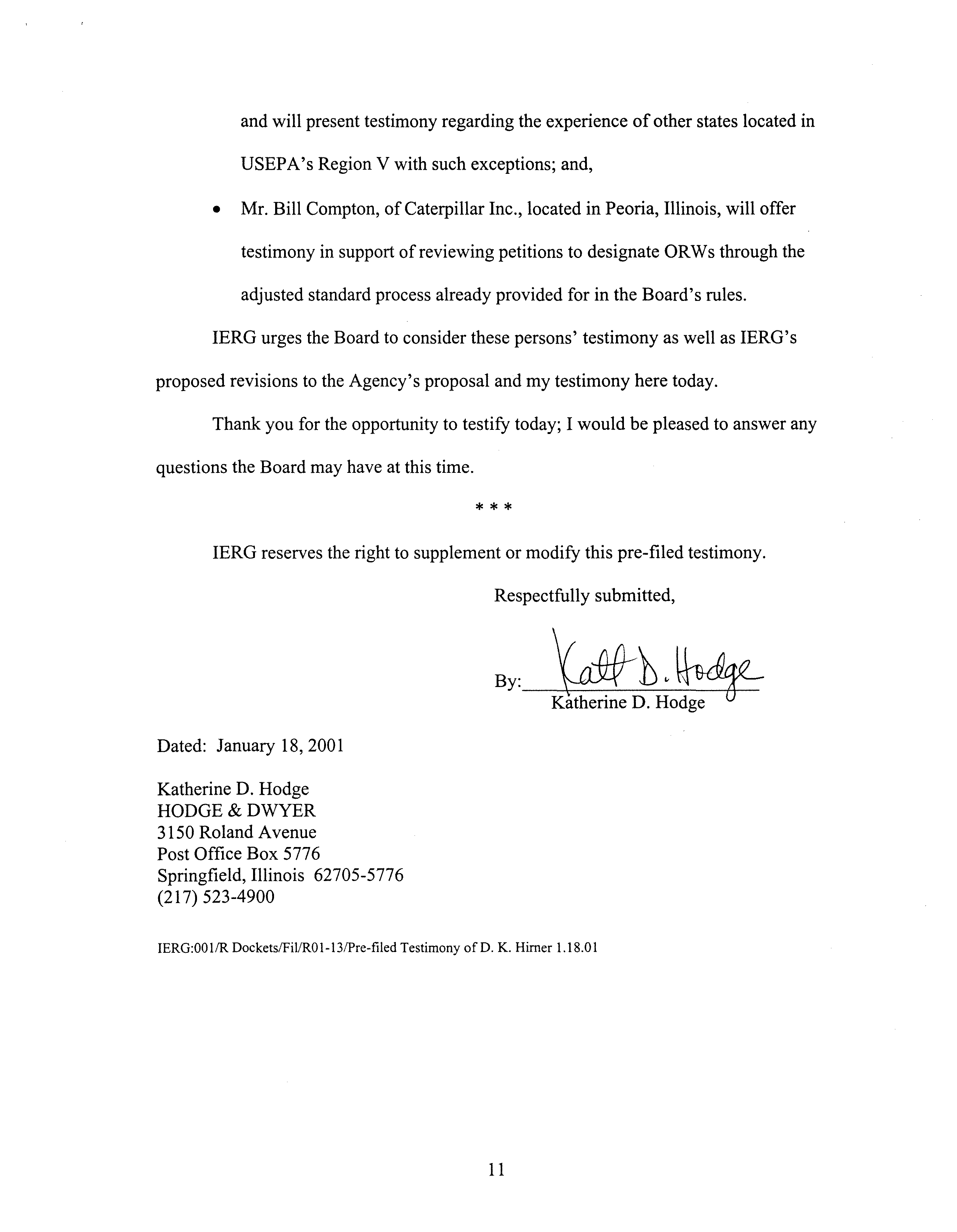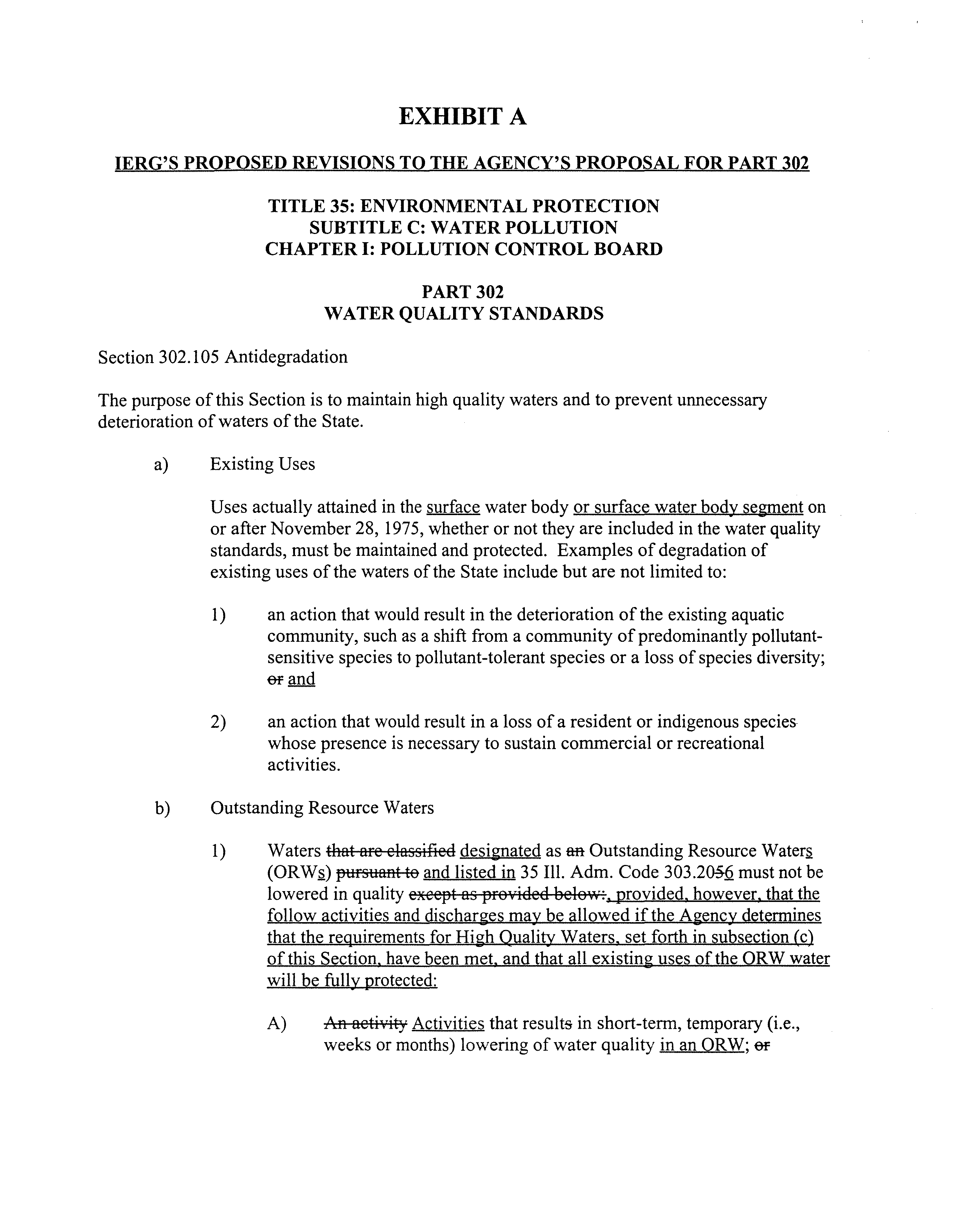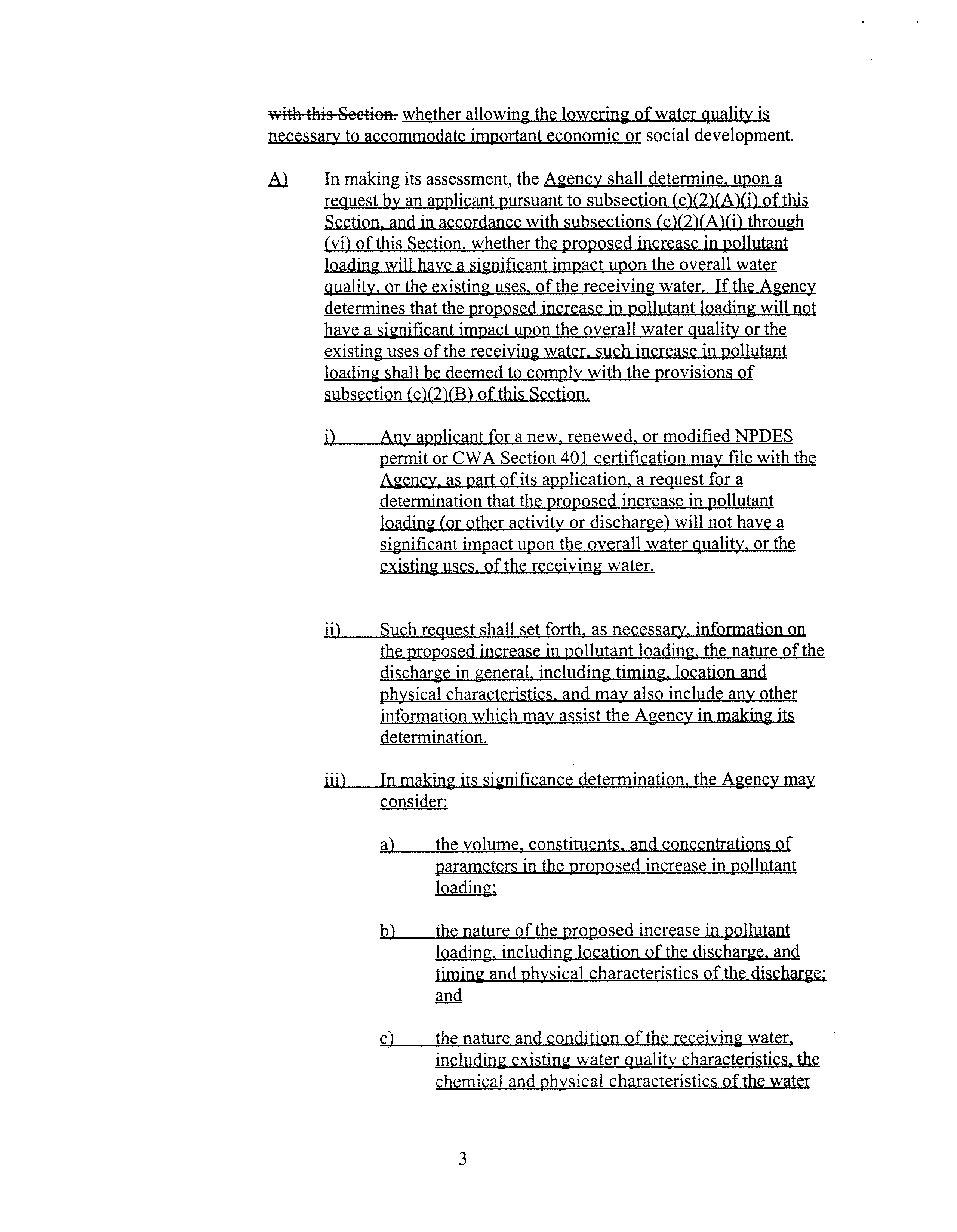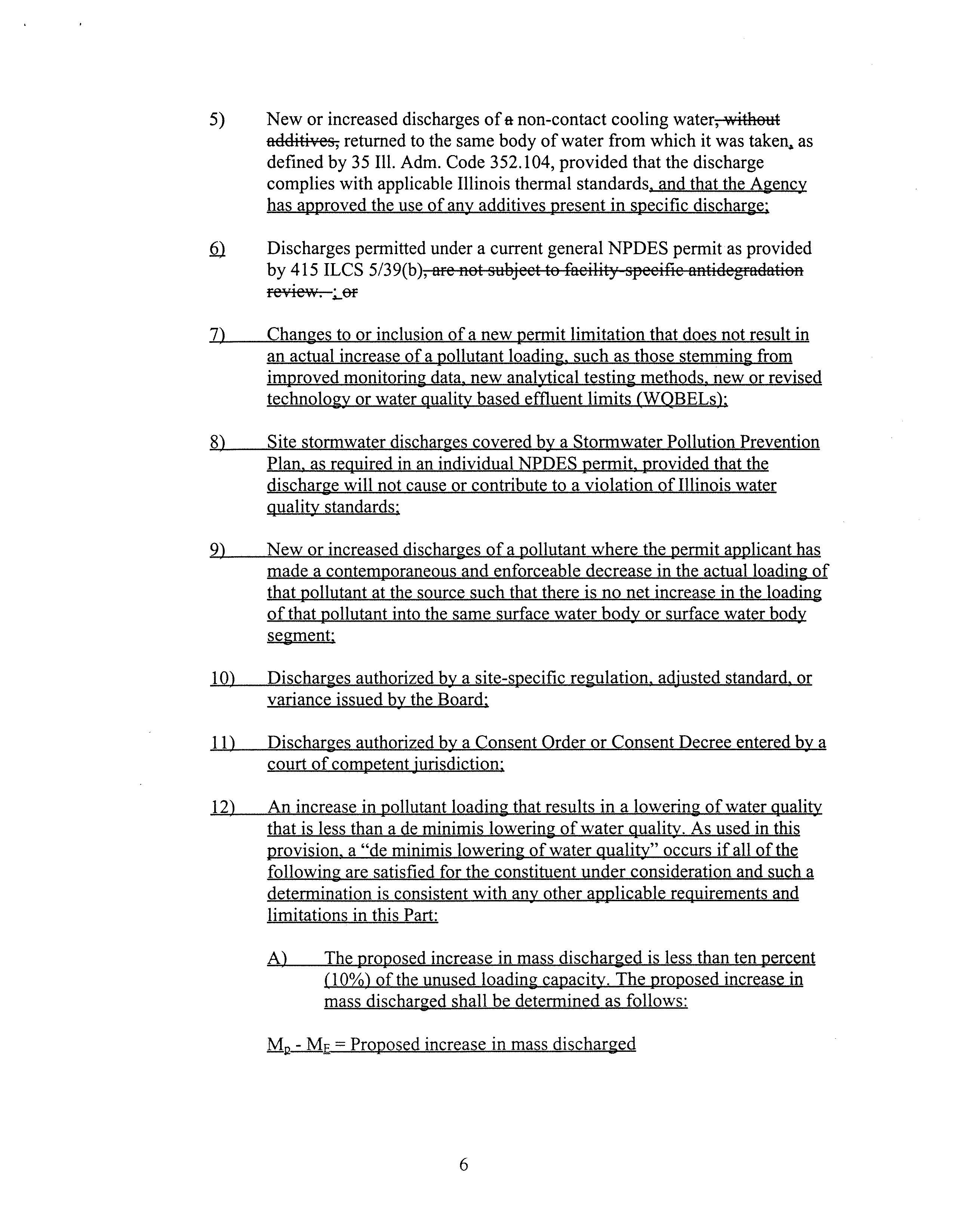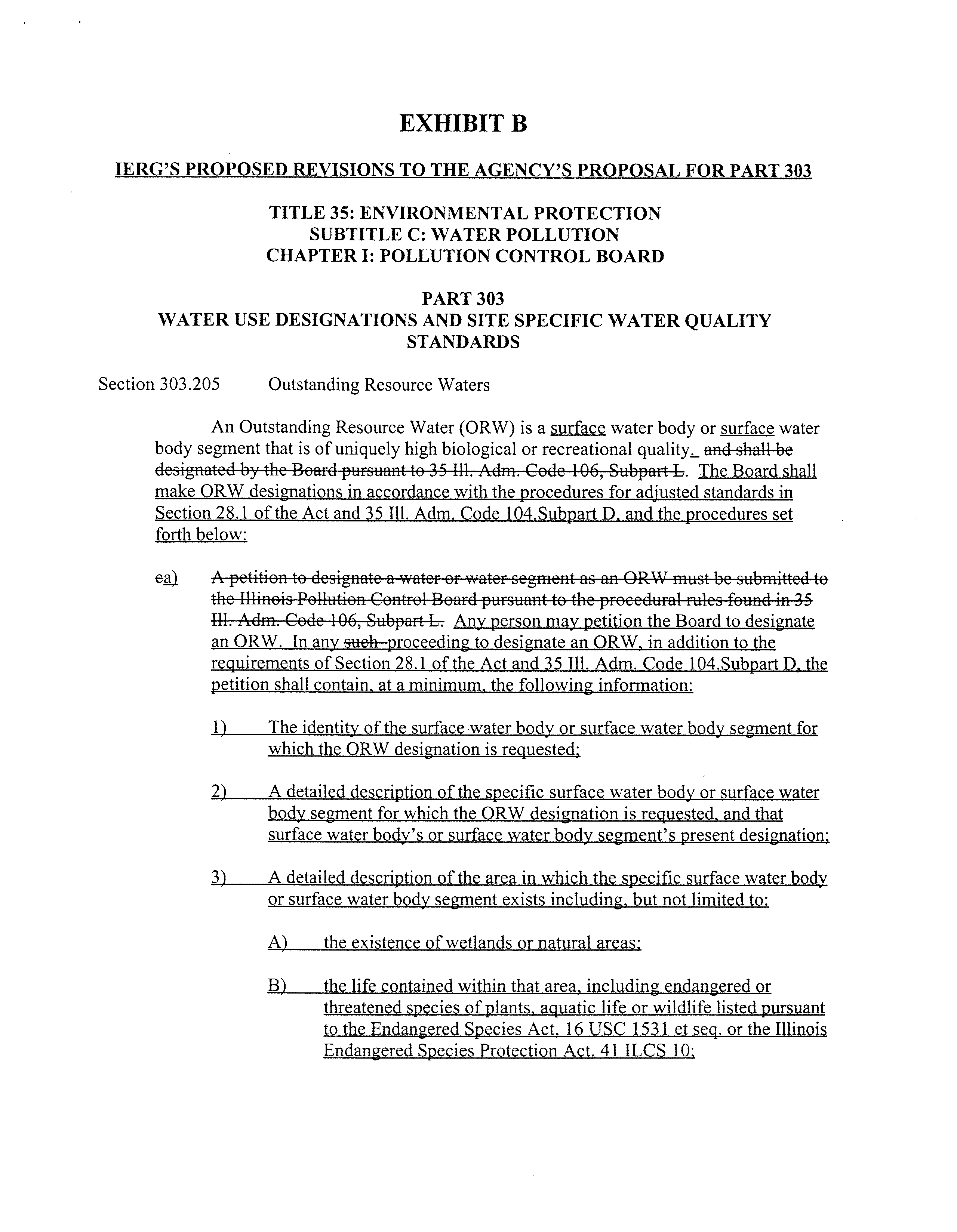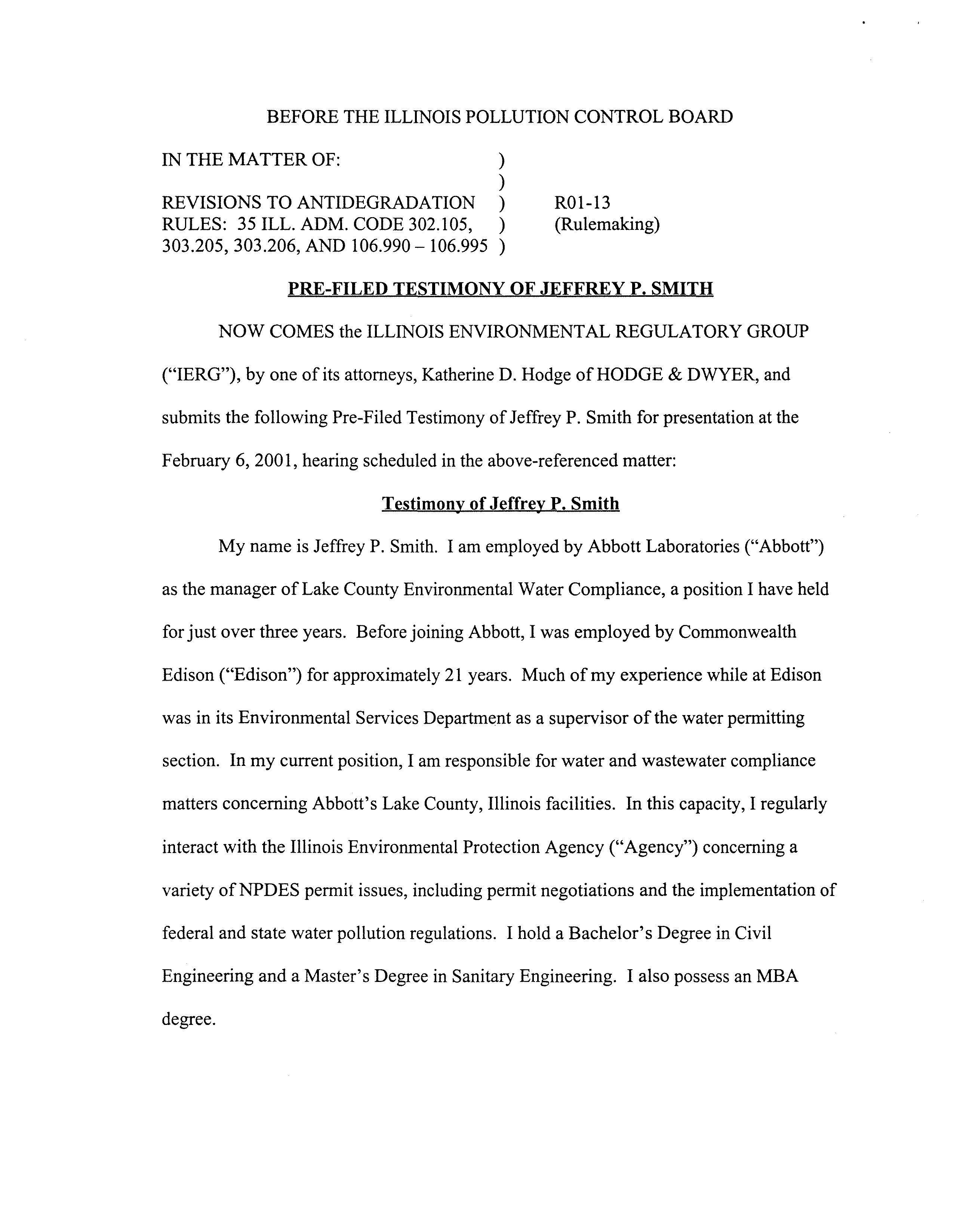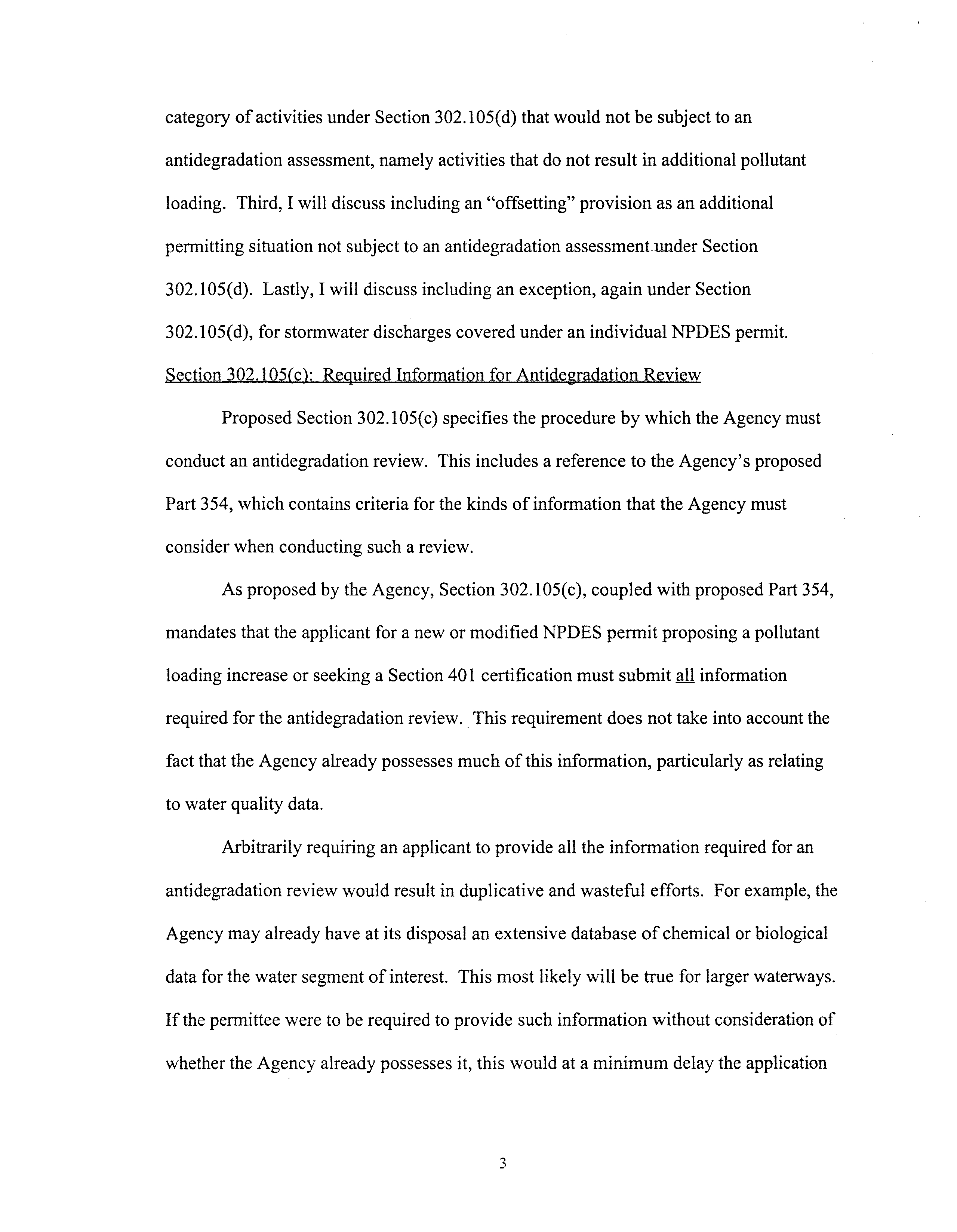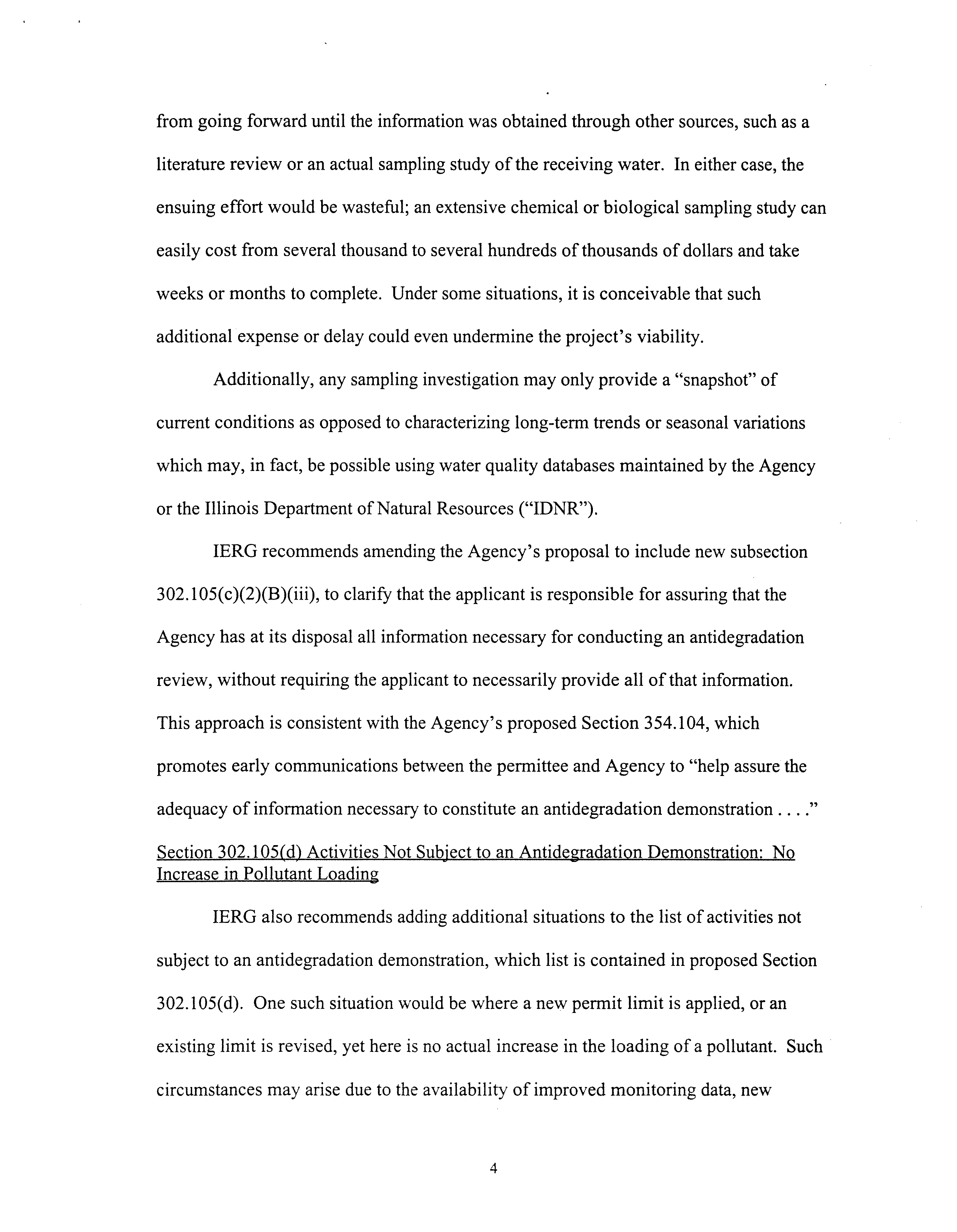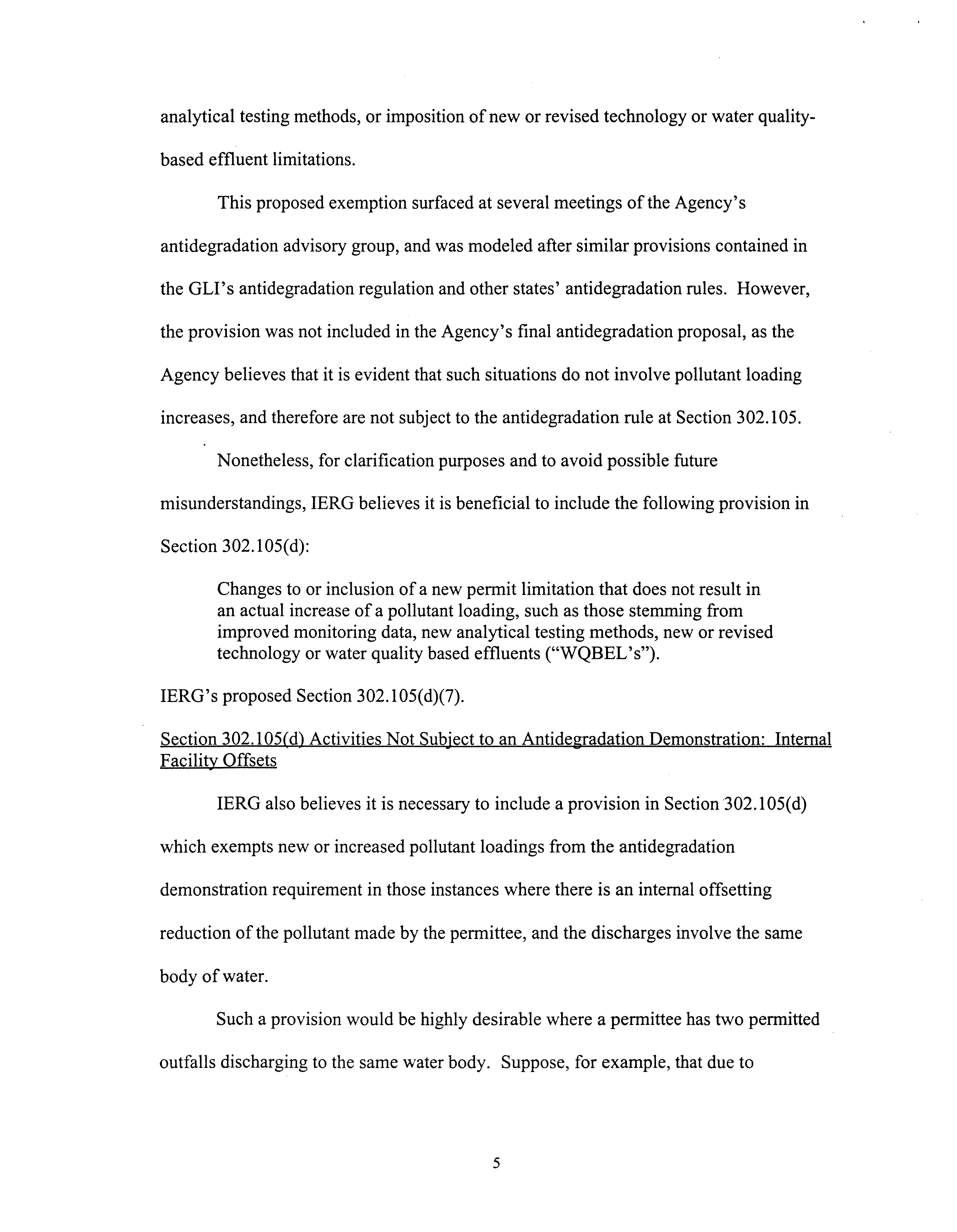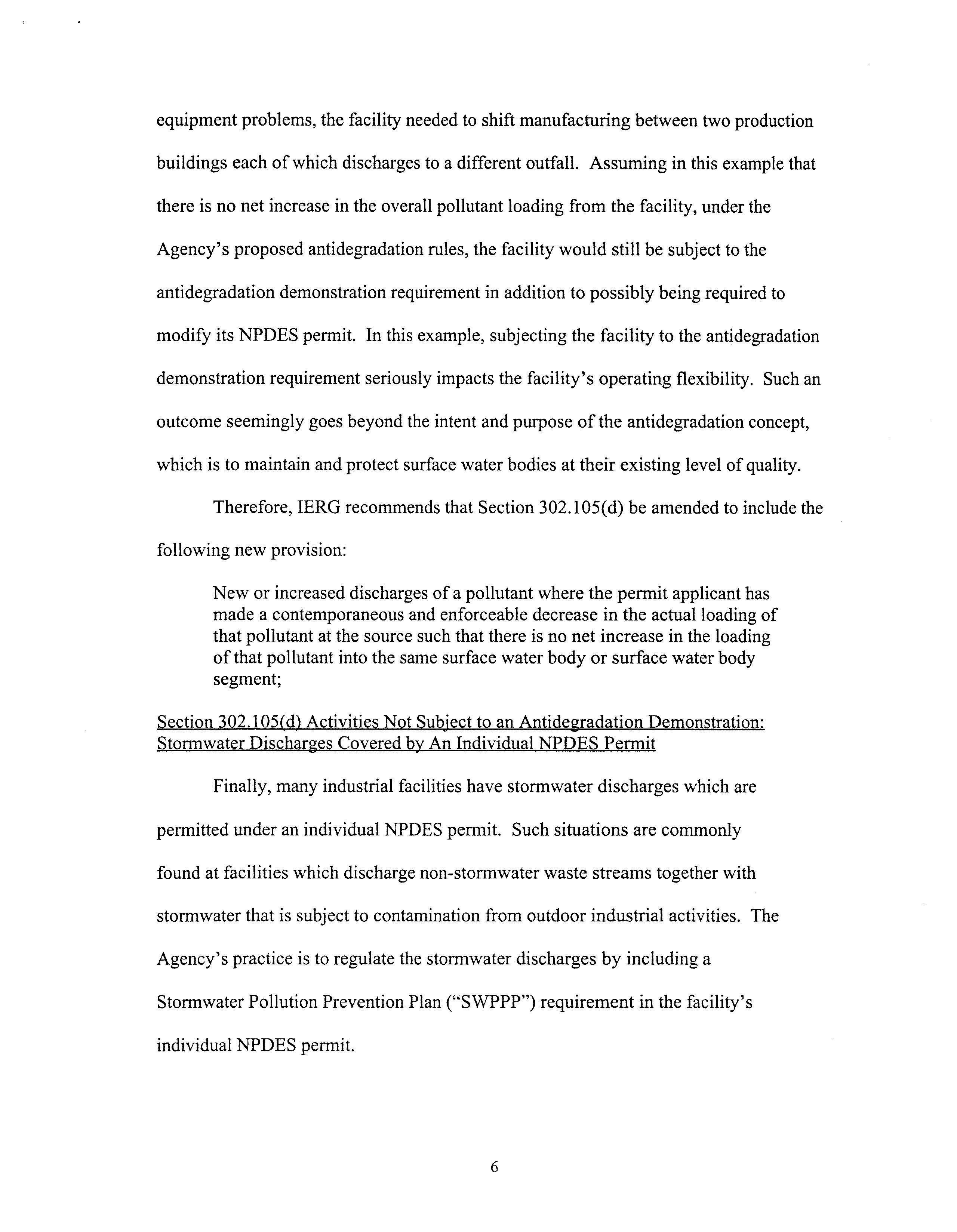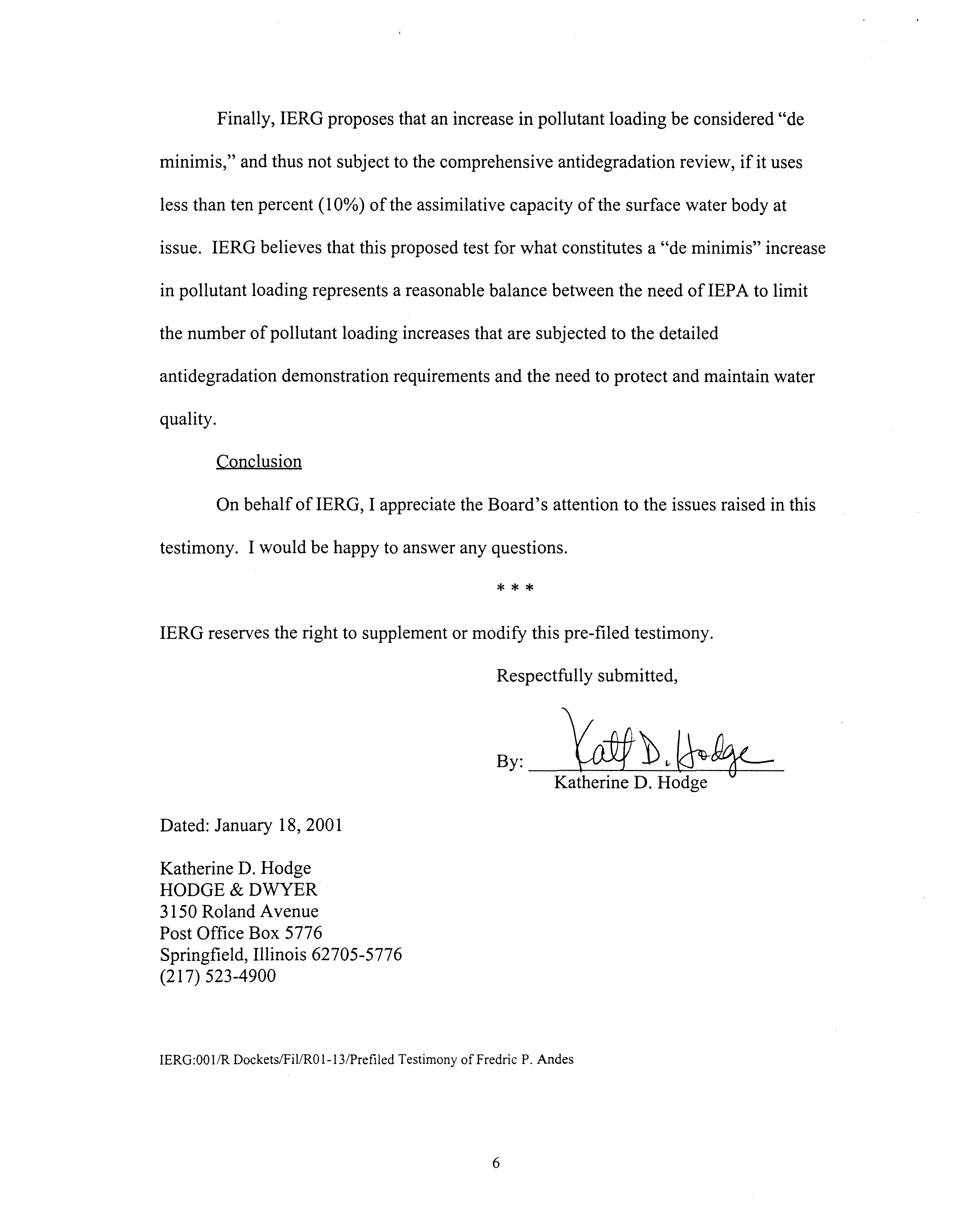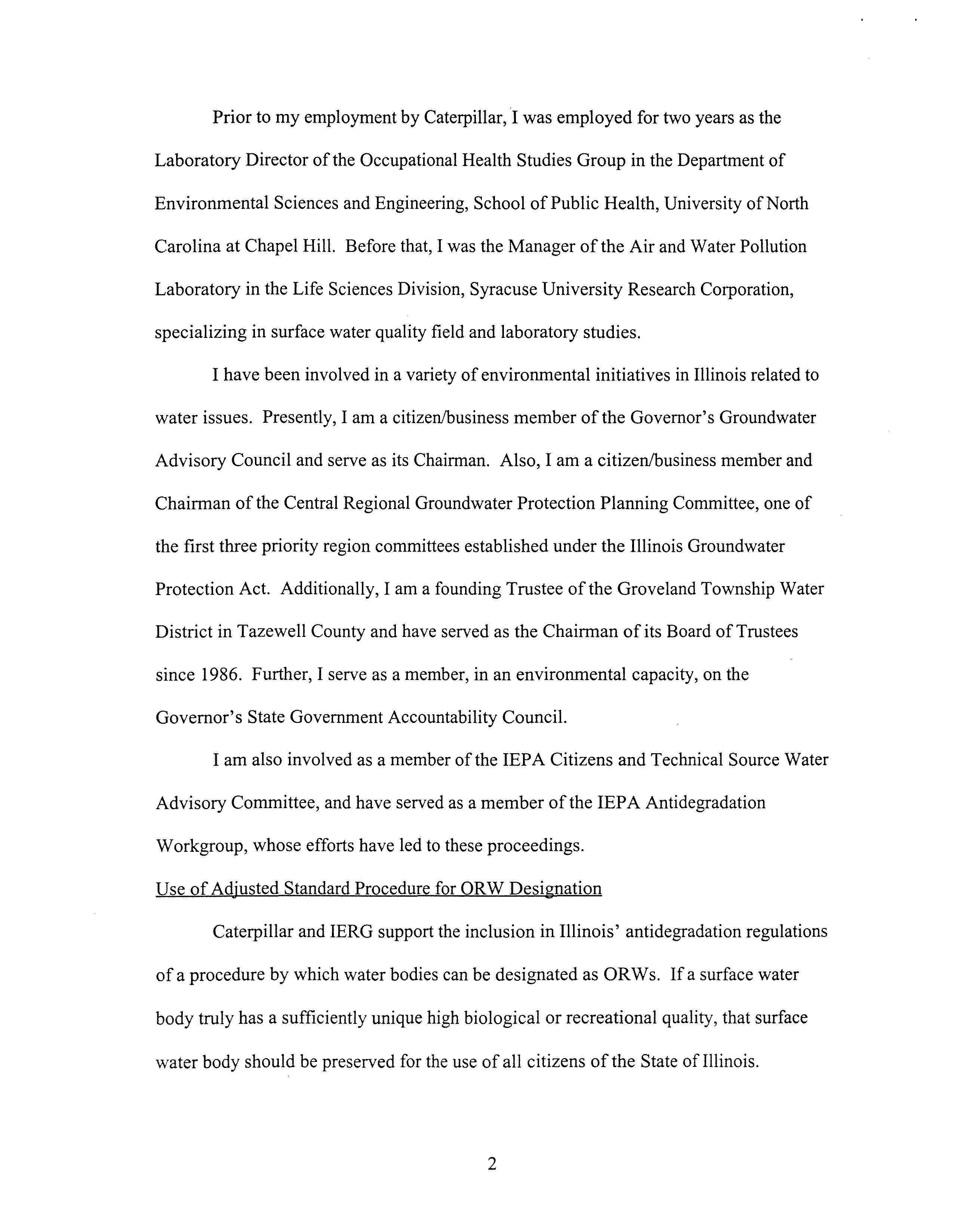BEFORE THE ILLINOIS POLLUTION CONTROL BOARD
IN THE MATTER OF:
REVISIONS TO ANTIDEGRADATION
RULES:
35
ILL. ADM. CODE 302.105,
303.205,
303.206, AND 106.990
—
106.995
)
NOTICE OF FILING
TO:
Ms. Dorothy M. Gunn
Clerk ofthe Board
Illinois Pollution Control Board
James R. Thompson Center
100 West Randolph Street
Suite 11-500
Chicago, Illinois 60601
(VIA
AIRBORNE EXPRESS)
Marie E. Tipsord, Esq.
Hearing Officer
Illinois Pollution Control Board
James R. Thompson Center
100 West Randolph Street
Suite 11-500
Chicago, Illinois 60601
(VIA
AIRBORNE EXPRESS)
(PERSONS ON
ATTACHED SERVICE LIST)
PLEASE TAKE NOTICE that I have filed today with the Clerk of the Illinois
Pollution Control Board an original and nine copies of PRE-FILED TESTIMONY
OF
DEIRDRE K. HIRNER, PRE-FILED TESTIMONY OF JEFFREY P. SMITH,
PRE-FILED TESTIMONY OF FREDERIC P. ANDES,
and
PRE-FILED
TESTIMONY OF BILL COMPTON,
copies ofwhich are herewith served upon you.
Dated: January 18, 2001
Respectfully submitted,
ILLINOIS ENVIRONMENTAL
REGULATORY GROUP,
By:
One ofIts Attorneys
Katherine D. Hodge
HODGE & DWYER
3150 Roland Avenue
Post Office Box 5776
Springfield, Illinois 62705-5776
(217) 523-4900
Karen L. Bernoteit
Illinois Environmental Regulatory Group
215 East Adams Street
Springfield, Illinois 62701
(217) 522-5512
)
)
)
)
RO 1-13
(Rulemaking)
THIS FILING SUBMITFED ON RECYCLED PAPER
CERTIFICATE OF SERVICE
I, Katherine D. Hodge, the undersigned, certify that I have served a copy of the
attached PRE-FILED TESTIMONY OF DEIRDRE K. HIRNER, PRE-FILED
TESTIMONY OF JEFFREY P. SMITH, PRE-FILED TESTIMONY OF FREDRIC P.
ANDES, and PRE-FILED TESTIMONY OF BILL COMPTON upon:
Ms. Dorothy M. Gunn
Clerk ofthe Board
Illinois Pollution Control Board
James R. Thompson Center
100 West Randolph Street
Suite 11-500
Chicago, Illinois 60601
Marie E. Tipsord, Esq.
Hearing Officer
Illinois Pollution Control Board
James R. Thompson Center
100 West Randolph Street
Suite 11-500
Chicago, Illinois 60601
by overnight delivery by depositing said documents in an Airborne Express drop box in
Springfield, Illinois, on January 18, 2001, and upon:
SEE ATTACHED SERVICE LIST
by depositing said documents in the United States Mail in Springfield, Illinois on
January 18, 2000.
~ Katherine D. Hodg
IERG:OO1/R Dockets!FiL’RO1-13 COS
—
Testimony
SERVICE LIST
Ms. Kay Anderson
American Bottoms RWTF
One American Bottoms Road
Sauget, Illinois 62201
Frederic P. Andes, Esq.
Barnes & Thornburg
2600 Chase Plaza
10 South LaSalle Street
Chicago, Illinois 60603
Ms. Christine Bianco
Director ofRegulatory Affairs
Chemical Industry Council ofIllinois
9801 West Higgins Road
Suite 515
Rosemont, Illinois 60018
Christine S. Bucko, Esq.
Assistant Attorney General
Illinois Attorney General’s Office
Environmental Bureau
188 West Randolph Street
20th Floor
Chicago, Illinois 60601
Mr. Jack Darn
Sierra Club, Illinois Chapter
200 North Michigan Avenue
Suite 505
Chicago, Illinois 60601
Mr. Albert F. Ettinger
Environmental Law & Policy Center
35 East Wacker Drive
Suite 1300
Chicago, Illinois 60601-2110
Susan M. Franzetti, Esq.
Sonnenschein Nath & Rosenthal
8000 Sears Tower
233 South Wacker Drive
Chicago, Illinois 60606
James T. Harrington, Esq.
Ross & Hardies
150 North Michigan Avenue
Suite 2500
Chicago, Illinois 60601
John M. Heyde, Esq.
Sidley & Austin
Bank One Plaza
10 South Dearborn Street
Chicago, Illinois 60603
Richard J. Kissel, Esq.
Gardner, Carton & Douglas
Quaker Tower
321 North Clark Street
Suite 3400
Chicago, Illinois 60610-4795
Sharon Marie Neal, Esq.
Law Department
CornEd
-
Unicorn
125 South Clark Street
Chicago, Illinois 60603
Mr. Jeny Paulson
McHenry County Defenders
804 Reginact
Woodstock, Illinois 60098
Mr. Irwin Polls
Metropolitan Water Reclamation District
Environmental Monitoring
6001 West Pershing Road
Cicero, Illinois 60804-4112
Ms. Cindy Skrudkrud
4209 West Solon Road
Richmond, Illinois 60071
Connie Tonsor, Esq.
Assistant Counsel
Division ofLegal Counsel
Illinois Environmental Protection Agency
1021 North Grand Avenue East
Post Office Box 19276
Springfield, Illinois 62794-9276
Ms. Georgia Vlahos
Department ofthe Navy
Naval Training Center
260lA Paul Jones Street
Great Lakes, Illinois 60088-2845
Charles W. Wesselhoft, Esq.
Ross & Hardies
150 North Michigan Avenue
Suite 2500
Chicago, Illinois 60601
Mr. Stanley Yonkauski
Illinois Department ofNatural Resources
524 South Second Street
Springfield, Illinois 62701
IERG:OO 1/Fil/RO1-1 3/Service List
BEFORE THE ILLINOIS POLLUTION CONTROL BOARD
IN THE MATTER OF:
)
)
REVISIONS TO ANTIDEGRADATION
)
R01-13
RULES: 35 ILL. ADM. CODE 302.105,
)
(Rulemaking)
303
.205,
303 .206, AND 106.990
—
106.995
)
PRE-FILED TESTIMONY OF DEIRDRE K. HIRNER
NOW COMES the ILLINOIS ENVIRONMENTAL REGULATORY GROUP
(“IERG”), by one of its attorneys, Katherine D. Hodge ofHODGE & DWYER, and
submits the following Pre-Filed Testimony ofDeirdre K. Hirner for presentation at the
February 6, 2001 hearing scheduled in the above-referenced matter:
Testimony of Deirdre K. Hirner
Good Morning. My name is Deirdre K. Hirner, and I am the Executive Director
of the Illinois Environmental Regulatory Group (“IERG”). I hold a Ph.D. in Land Use
Planning from Texas Tech University, have served in the Office ofGovernor of the State
of Missouri as Chief Public Policy Advisor, and was, for six years, the Director of
Missouri’s largest conservation group, the 35,000-member Conservation Federation,
which focused on building broad-based support for a balanced approach to environmental
protection measures.
On behalf ofIERG and its member companies, I want to thank the Illinois
Pollution Control Board (“Board”) for the opportunity to present this testimony today.
As some ofyou may know, IERG requested that the Board schedule this third hearing for
the purpose of allowing additional testimony in response to the proposal ofthe Illinois
Environmental Protection Agency (“Illinois EPA” or “Agency”). IERG appreciates the
fact that the Board granted this request and is holding this hearing today. IERG believes
that this hearing will provide the Board valuable information that will allow the Board to
more completely consider the Agency’s proposal and promulgate a fairer and more
effective final rule.
My testimony today is offered to present IERG’s proposed revisions to the
Agency’s proposal and to provide more detailed testimony on IERG’s areas ofconcern
with that proposal and in support of IERG’s proposed revisions. In conjunction with my
testimony today, representatives of two of IERG’s member companies, and attorney Fred
Andes of the law firm of Barnes & Thornburg, will present testimony in support of
IERG’s proposed revisions.
Background
As I noted in my testimony on behalfofIERG at the December 6, 2000, hearing
in this matter, IERG has several general areas of concern regarding the Agency’s
proposal. Again, those areas ofconcern are as follows:
1.
the Agency’s proposal does not contain a significance test to
determine the need for a comprehensive antidegradation review;
2.
the Agency’s proposal does not contain needed exceptions to the
individual demonstration pursuant to the proposed Board standard;
3.
the Agency’s proposal requires extensive up-front data
submissions from an applicant for an NPDES permit or Section 401 certification
which may not be necessary;
4.
the Agency’s proposal does not contain sufficient requirements for
ORW designations; and
2
5.
the Agency’s proposal lacks clarity as it relates to definitions of
some ofthe provisions and terms proposed.
In preparation for this hearing, IERG has filed proposed revisions to the Agency’s
proposal that address IERG’s concerns. See Exhibit A to my pre-filed testimony, which
contains IERG’s Proposed Revisions to the Agency’s Proposal for Part 302 and Exhibit
B, which contains IERG’s Proposed Revisions to the Agency’s Proposal for Part 303. I
would like to take this opportunity to briefly explain IERG’s proposed revisions and to
demonstrate how those revisions would result in a clearer, more workable set of
regulations that would still accomplish the goal ofantidegradation.
Significance Determination
As noted in my December 6, 2000 testimony, the business community believes
that antidegradation procedures should be applied in a tiered fashion similar to that
practice suggested in USEPA’s Region VIII Guidance: “Antidegradation
Implementation,” dated August 1993. The first step in this process should be a
determination ofwhether a proposed action is ofsuch significance that a formal
antidegradation review is necessary. Ifnot, a finding ofinsignificance should, in and of
itself, constitute an appropriate antidegradation review. IERG firmly believes that some
increased loadings warrant an insignificance determination because they are, by their
nature, ofsuch limited significance that they do not require a comprehensive
antidegradation assessment.
Accordingly, IERG has proposed a revision to the Agency’s proposed Section
302.l05(c)(2) that would provide for such a tiered approach. IERG’s proposed revision
would allow applicants for certain new, renewed, or modified NPDES permits or CWA
3
Section 401 certifications to ask the Agency, as part of its application, to determine
whether the proposed increase in pollutant loading or other activity or discharge will have
a significant impact on the overall water quality or existing uses ofthe receiving water.
Any applicant seeking such a determination would be required to provide the Agency
necessary information relating to the nature of the proposed discharge and the quality and
characteristics ofthe receiving water to assist the Agency in making the determination.
If the Agency determined that the proposed increase in pollutant loading or
activity or discharge would nQI have a significant impact on the overall water quality or
existing uses ofthe receiving water, no further review would be required. Ifthe Agency
determined that the proposed increase in pollutant loading or activity or discharge would
have a significant impact on the overall water quality or existing uses ofthe receiving
water, the Agency would conduct a further review ofthe application. This further review
would assure that (1) the applicable numeric or narrative water quality standard will not
be exceeded as a result ofthe proposed activity; (2) all existing uses ofthe receiving
water will be fully protected; (3) all technically and economically reasonable measures to
avoid or minimize the extent ofthe proposed increase in pollutant loading have been
incorporated into the proposed activity; and, (4) the proposed activity will benefit the
community at large. Details ofthe Agency’s significance determination would be
included in the permit fact sheet, a component ofthe Agency’s proposed implementation
procedures.
Incorporating this tiered approach into the antidegradation review procedure is
consistent with the exceptions from antidegradation review contained in the Agency’s
proposed Section 302.105(d). The fact that the Agency has included such exceptions in
4
that provision recognizes that some effects on water quality are truly insignificant and
should not be subjected to a comprehensive antidegradation review. IERG’s proposed
inclusion ofa tiered approach to antidegradation review expands on this concept by
providing for only a limited review of those proposed discharges that are not excepted
from review under proposed Section 302.105(d) but are still “insignificant.” This will
allow proponents ofproposed discharges and the Agency to protect water quality by
focusing their time and resources on those increased loadings that truly are “significant.”
Limited Exceptions
The Agency has recognized the need for exceptions to the requirement for a
comprehensive antidegradation assessment by including six such exceptions in proposed
Section 302.105(d). IERG applauds the Agency’s recognition ofthe need for exceptions
to a comprehensive antidegradation review. As stated in my December 6, 2000
testimony, the absence of such exceptions would bog the Agency down in an endless
review ofpermits that have virtually no environmental impact.
IERG has proposed that additional, similar exceptions be included in proposed
Section 302.105(d). Many of these proposed exceptions have been implemented by other
Region V states. Mr. Fred Andes of the law firm ofBarnes & Thornburg will present
testimony regarding the experience of these other states with these exceptions and in
support ofthe inclusion ofthese exceptions in Illinois’ regulations.
As Mr. Andes testimony will demonstrate, like the exceptions proposed by the
Agency, none ofthe exceptions proposed by IERG would pose any threat to the quality
ofwater in Illinois. Rather, they would only allow for activities that (1) are already in
compliance with other applicable laws to go forward without subjecting the persons
5
conducting those activities to the time and expense ofanother review of information that
either the state or federal government has already reviewed, and/or (2) result in an
improvement to water quality.
IERG has also proposed an exception for increases in pollutant loading that would
result in a de minimis lowering of water quality. By the term “de minimis,” IERG means
that the proposed increase in mass discharge is less than ten percent (10) ofthe unused
loading capacity of the receiving water.
Several other states in USEPA’s Region V have found such a de minimis
approach to be workable and protective ofwater quality. Further, the Agency indicated
at the November 17, 2000 hearing in this matter that it was not opposed to the concept of
a de minimis exception to the requirement ofa comprehensive antidegradation review.
Mr. Andes will provide further testimony in support of this de minimis exception.
Up-Front Data Submissions
As noted in my previous testimony, while IERG agrees that the Agency must
have the information that it needs to conduct an antidegradation review, IERG believes
that the language proposed by the Agency places an undue burden upon an applicant for
an NPDES permit or a Section 401 certification to provide volumes of information that
may be unnecessary for the Agency to thoroughly conduct its review. Accordingly,
IERG has proposed revisions to proposed Section 302.105 that would require applicants
to file only information that is necessary for the Agency’s review. The Agency would, of
course, be able to request any further information that it required.
This proposed revision gives the Agency the ability to exercise discretion as to
what information applicants must submit and lessens the burden on applicants by
6
relieving them of the obligation to file information that would not be helpful to the
Agency. Further, this proposed revision is consistent with the testimony of Agency
witness Toby Frevert at the November 17, 2000, hearing in this matter, where Mr. Frevert
stated that there are many instances in which some ofthe data submissions required by
the Agency’s proposed rule would not be needed by the Agency to conduct its
antidegradation review.
S~
November 17, 2000, Transcript at pp. 78 to 80.
IERG has also proposed a revision at subsection 302.
105(c)(2)(B)(iii)
that would
allow the Agency to rely on its own data sources when conducting an antidegradation
review, such as data or reports in the Agency’s possession and Agency experience with
factually similar permitting scenarios. This data will be invaluable to the Agency when
conducting an antidegradation review, and this regulation should explicitly provide that
the Agency is authorized to consider such data when conducting such a review. Further,
IERG’s proposed revision is consistent with the testimony of Mr. Frevert at the
November 17, 2000, hearing in this matter indicating that the Agency intends to consider
any information at its disposal when conducting an antidegredation review, regardless of
where that information came from. ~ November 17, 2000, Transcript at pp. 61 to 63.
ORW Designations
As the Agency recognized at the November 17, 2000, hearing in this matter, the
designation ofa water body as an ORW has the potential for profound economic impact,
environmental restriction and broad ramifications for surrounding property owners,
particularly in terms of land use options. ~ November 17, 2000, Transcript at pp. 88 to
89. The implication of designating a stream segment as an ORW is well beyond
protecting biological and recreational values of unique waters; it is land use regulation.
7
Accordingly, IERG has proposed revisions to clarify the process by which an ORW
designation would occur.
First, IERG has proposed a revision to proposed Section 303.205 to clarify that
the process by which a person may petition the Board for designation of a water body as
an ORW is the adjusted standard procedure contained in Section 28.1 ofthe Act (415
ILCS 5/28.1) and Subpart D of Part 104 of Title 35 ofthe Illinois Administrative Code.
(35 Ill. Admin. Code Part 104.Subpart D) IERG proposes this clarification because of
the analogy between ORWs and Class III Groundwater, the designation of which takes
place through the adjusted standard procedure. Further, clarifying that a person seeking
to designate a water body as an ORW must follow the adjusted standard procedure
provides a clearer framework for those seeking such designation, and those who would be
affected by such designation, than the Agency’s current proposal.
Second, IERG has proposed further revisions to proposed Section 303.205 to
clarify that the burden of proofin a proceeding to designate a water body as an ORW is
on the person seeking such a designation, and to clarify what information a person
seeking an ORW designation must submit in support ofthat designation. Again, the
designation of a water body as an ORW has the potential for profound economic impact
and environmental restriction. Due process mandates that a person seeking to create such
an impact has the burden of establishing that such impact is justified, and further
mandates that property owners’ rights not be taken away from them without a
consideration ofall relevant information. Mr. Bill Compton will provide further
testimony in support ofIERG’s proposed revisions to Part 303.
8
Clarity
Finally, as noted in my December 6, 2000, testimony, IERG has identified several
primary areas ofconcern that it feels require clarification in the proposed rule. IERG has
proposed revisions to the rule to effect the necessary clarification. Most significantly,
IERG has proposed a revision in proposed Section 302.105(c)(2) to clarify that the
minimum threshold to trigger an antidegradation review is “an increase in pollutant
loading that necessitates a new, renewed, or modified NPDES permit, with a new or
increased permit limit” (or a CWA Section 401 certification). Specifically, IERG has
proposed a revision to proposed Section 302.105 to make clear that the requirements for
an antidegradation review do not apply to all loadings “subject” to an NPDES permit, but
only to any permit application for a new, renewed or modified NPDES permit that
requires a new or increased limit. This proposed revision is consistent with the testimony
of Mr. Frevert at the November 17, 2000, hearing in this matter that the Agency’s
proposed rule would not apply “were there is no proposed increase in any pollutant
parameter activity.” November 17, 2000, Transcript at p. 45, 11. 1-2.
Also, IERG believes that revisions to the Agency’s Part 354 are necessary. IERG
ofcourse understands that Part 354 is not before the Board in this proceeding. But, the
Agency has submitted its proposed Part 354 to the Board in this proceeding, and this
provision is relevant to this proceeding, as it demonstrates the Agency’s intended
approach for implementing proposed Sections 302A05 and 303.205. While we intend to
provide our proposed revisions to Part 354 to the Agency, we believe the most significant
revision to Part 354 should be to provide that a permit applicant for a new, renewed or
modified NPDES permit must only submit that information that is necessary for the
9
Agency to determine whether any increase in pollutant loading or other proposed activity
would result in degradation of the receiving water. IERG intends to request that Section
354.103 be revised to provide that the Agency may request additional information from
an applicant to assist the Agency in its antidegradation review, as well.
Additionally, IERG has proposed further revisions to the Agency’s proposal for
Parts 302 and 303 to clarify our understanding of the Agency’s intent, based on the
testimony offered at the prior hearings.
Conclusion
As noted above, in addition to my testimony, representatives oftwo IERG
member companies, and attorney Fred Andes, are presenting testimony today in support
of IERG’s proposed revisions to the Agency’s proposal. Specifically,
Mr. Jeffrey Smith, ofAbbott Laboratories, located in North Chicago, Illinois,
will present testimony regarding the general requirement proposed by the
Agency that the burden for providing all information necessary for the
Agency to conduct an antidegradation assessment be placed entirely on the
permittee when, in fact, some or all ofthe required information may already
reside within the Agency, and in support ofIERG’s proposal to include
additional categories ofactivities as exceptions in proposed Section
302. 105(d).
•
Mr. Fred Andes, ofthe law firm of Barnes & Thornburg, will also present
testimony in support of IERG’s proposed process for significance
determination and additional exceptions from further antidegradation review,
10
and will present testimony regarding the experience ofother states located in
USEPA’s Region V with such exceptions; and,
• Mr. Bill Compton, of Caterpillar Inc., located in Peoria, Illinois, will offer
testimony in support of reviewing petitions to designate ORWs through the
adjusted standard process already provided for in the Board’s rules.
IERG urges the Board to consider these persons’ testimony as well as IERG’s
proposed revisions to the Agency’s proposal and my testimony here today.
Thank you for the opportunity to testify today; I would be pleased to answer any
questions the Board may have at this time.
* **
IERG reserves the right to supplement ormodify this pre-filed testimony.
Respectfully submitted,
By:
~C~L
Kathenne D. Hodge
Dated: January 18, 2001
Katherine D. Hodge
HODGE & DWYER
3150 Roland Avenue
Post Office Box 5776
Springfield, Illinois 62705-5776
(217) 523-4900
IERG:OO1/R Dockets/FiIIRO1-13/Pre-fi!ed Testimony of D. K. Hirner 1.18.01
11
EXHIBIT A
IERG’S PROPOSED REVISIONS TO THE AGENCY’S PROPOSAL FOR PART 302
TITLE
35:
ENVIRONMENTAL PROTECTION
SUBTITLE C: WATER POLLUTION
CHAPTER I: POLLUTION CONTROL BOARD
PART 302
WATER QUALITY STANDARDS
Section 302.105 Antidegradation
The purpose ofthis Section is to maintain high quality waters and to preventunnecessary
deterioration of waters ofthe State.
a)
Existing Uses
Uses actually attained in the surface water body or surface water body segment on
or after November 28,
1975,
whether or not they are included in the water quality
standards, must be maintained and protected. Examples ofdegradation of
existing uses ofthe waters ofthe State include but are not limited to:
1)
an action that would result in the deterioration of the existing aquatic
community, such as a shift from a community ofpredominantly pollutant-
sensitive species to pollutant-tolerant species or a loss ofspecies diversity;
e~and
2)
an action that would result in a loss ofa resident or indigenous species-
whose presence is necessary to sustain commercial or recreational
activities.
b)
Outstanding Resource Waters
1)
Waters that arc classified designated as ~ Outstanding Resource Waters
(ORW~)pursuant to and listed in 35 Ill. Adm. Code 303 .20~must not be
lowered in quality cxcept as providcd bclow:. provided, however, that the
follow activities and discharges may be allowed if the Agency determines
that the requirements for High Quality Waters. set forth in subsection (c)
ofthis Section. have been met. and that all existing uses of the ORW water
will be fully protected:
A)
An activity Activities that results in short-term, temporary (i.e.,
weeks or months) lowering of water quality in an ORW e~
B)
Existing site stormwater discharges into an ORW that comply with
applicable federal and state storm watcr stormwater management
regulations and th~Ido not result in a violation ofany water quality
standards; and
C)
Activities that result in an increase in pollutant loading into an
ORW that necessitates the issuance of a new, renewed, or modified
Thc proponent of any activity requiring a National Pollutant
Discharge Elimination System (NPDES) permit. with a new or
increased permit limit, or a Clean Water Act (CWA) Section 401
certification, is required. provided that the proposed increase in
pollutant loading is necessary for an activity that will improve
water quality in the ORW and that such water quality improvement
could not be practicably achieved without the proposed increase in
pollutant loading, must also submit a demonstration to thc Agcncy
meeting thc rcquircmcnts of subsections b(2) and c(2) of this
Section.
—J
i
He activities referenced in subsection (b)(1) or proposed
pollutant loading
A)
All existing uses of the ORW water will be fully protected;
B)
in~~~.~4f1-r
~
loading is
~
for an
activity that will improve water quality in the ORW; and
C)
The improvement
practicably achieved without the
i~rnr”~~
increase in pollutant loading.
3)
Any proposed increase in pollutant loading requiring an NPDES permit or
a CWA 401 certification for an ORW must be assessed nursuant to 35 Ill.
Adm. Code Part 354 to determine ~nmn1innr’
with this Section.
c)
High Quality Waters
1)
Except as otherwise provided in subsection (d) of this Section, waters of
the State whose existing quality exceeds established standards ofthis Part
must be maintained in their present high quality, unless the Agency
determines, the proponent can demonstrate pursuantto subsection (c)(2) of
this Section, that allowing the lowering ofwater quality~is necessary to
accommodate important economic or social development.
2)
Any proposed increase in pollutant loading that necessitates a new.
renewed, or modified subject to a NPDES permit, with a new or increased
-
permit limit, or ~ CWA Section 401 eertification~must be assessed by the
Agency pursuant to 35 Ill. Adm. Code Part 354 to determine compliance
~f
tnn~
with this Section. whether allowing the lowering ofwater quality is
necessary to accommodate important economic or social development.
A)
In making its assessment, the Agency shall determine, upon a
request by an applicant pursuant to subsection (e)(2)(A)(i) ofthis
Section. and in accordance with subsections (c)(2)(A)(i) through
(vi) ofthis Section. whether the proposed increase in pollutant
loading will have a significant impact upon the overall water
quality, or the existing uses, of the receiving water. Ifthe Agency
determines that the proposed increase in pollutant loading will not
have a significant impact upon the overall water quality or the
existing uses of the receiving water, such increase in pollutant
loading shall be deemed to comply with the provisions of
subsection (c)(2)(B) ofthis Section.
i)
Any applicant for a new. renewed, or modified NPDES
permit or CWA Section 401 certification may file with the
Agency. as part ofits application, a request for a
determination that the proposed increase in pollutant
loading (or other activity or discharge) will not have a
significant impact upon the overall water quality, or the
existing uses, ofthe receiving water.
ii)
Such request shall set forth. as necessary, information on
the proposed increase in pollutant loading, the nature of the
discharge in general. including timing. location and
physical characteristics. and may also include any other
information which may assist the Agency in making its
determination.
iii)
In making its significance determination, the Agency may
consider:
a)
the volume. constituents. and concentrations of
parameters in the proposed increase in pollutant
loading:
b)
the nature ofthe proposed increase in pollutant
loading, including location of the discharge. and
timing and physical characteristics ofthe discharge:
and
c)
the nature and condition ofthe receiving water.
including existing water quality characteristics, the
chemical and physical characteristics ofthe water
3
and of the water body, and any relevant biological.
chemical, or physical characteristics ofthe water
which will affect the impact ofthe proposed
increase in pollutant loading upon the waterway.
Or. alternatively the Agency may consider whether the
applicable numeric or narrative water quality standard will
not be exceeded as a result ofthe proposed activity and
whether all existing uses will be fully protected.
iv)
In making its significance determination, the Agency may
utilize the information sources set forth in subsection
(e)(2)(B)(iii) of this Section.
vi)
The Agency shall make significance determinations in
accordance with its antidegradation implementation
procedures.
vi)
Ifthe Agency determines that the proposed increase in
pollutant loading is significant. it shall so inform the
applicant, in which ease, the applicant then may comply
with the provisions of subsection (e)(2)(B) of this Section
or may appeal the Agency’s determination to the Board in
accordance with 35 Ill. Adm. Code 105.Subpart B.
B)
Ifthe Agency determines that the proposed increase in pollutant
loading will have a significant impact upon the overall water
quality or the existing uses ofthe receiving water, such proposed
increase in pollutant loading shall be assessed by the Agency in
accordance with its antidegradation implementation procedures. In
making its assessment:
The Agency shall consider the fate and effect of any
parameters proposed for an increased pollutant loading~
i
tie nrnnnn~nt of an increased pollutant loading shall
demonstrate the following: The Agency shall determine
whether:
a)
The applicable numeric or narrative water quality
standard must
~ffl
not be exceeded as a result ofthe
proposed activity;
b)
All existing uses must
~ifl
be fully protected;
4
c)
All technically and economically reasonable
measures to avoid or minimize the extent of the
proposed increase in pollutant loading load increase
have been incorporated into the proposed activity;
and
d)
The activity that results in ~ ih~
increase4 In
pollutant loading
mt~st
~fflbenefit the community
at large.
iii)
In making its assessment. the Agency may utilize the
following information sources:
a)
Information, data or reports available to the Agency
from its own sources:
b)
Information, data or reports supplied by the
applicant:
c)
Agency experience with factually similar permitting
scenarios: and/or
d)
Any other valid information available to the
Agency.
d)
Activities Not Subject to a Further Antidegradation Demonstration Assessment
The following activities shall be deemed to comply with the provisions ofthis
Section and shall not be subject to ai~a further antidegradation demonstration
assessment pursuant to subsection (c) ofthis Section.
1)
Short-term, temporary (i.e., weeks or months) lowering ofwater quality;
2)
Bypasses that are not prohibited at 40 CFR 122.4 1(m);
3)
Response actions pursuant to the Comprehensive Environmental
Response, Compensation and Liability Act (CERCLA), as amended, or
corrective actions pursuant to the Resource Conservation and Recovery
Act (RCRA). as amended, or similar federal or State authority, taken to
alleviate a release into the environment ofhazardous substances,
pollutants or contaminants which may pose a danger to public health or
welfare;
4)
Thermal diseharge~that has have been approved through a CWA Section
-
316(a) demonstration;
5)
New or increased discharges of a non-contact cooling water, without
additives, returned to the same body of water from which it was taken~as
defined by 35 Ill. Adm. Code 352.104, provided that the discharge
complies with applicable Illinois thermal standards. and that the Agency
has approved the use ofany additives present in specific discharge:
Discharges permitted under a current general NPDES permit as provided
by 415 ILCS
5/39(b),
are not subject to facility specific antidegradation
review. ~
7)
Changes to or inclusion ofa new permit limitation that does not result in
an actual increase of a pollutant loading, such as those stemming from
improved monitoring data. new analytical testing methods. new orrevised
technology or water quality based effluent limits (WQBELs):
8)
Site stormwater discharges covered by a Stormwater Pollution Prevention
Plan. as required in an individual NPDES permit. provided that the
discharge will not cause or contribute to a violation of Illinois water
quality standards:
9)
New or increased discharges ofa pollutant where the permit applicant has
made a contemporaneous and enforceable decrease in the actual loading of
that pollutant at the source such that there is no net increase in the loading
ofthat pollutant into the same surface water body or surface water body
segment:
10)
Discharges authorized by a site-specific regulation. adjusted standard. or
variance issued by the Board:
11)
Discharges authorized by a Consent Order or Consent Decree entered by a
court ofcompetentjurisdiction:
12)
An increase in pollutant loading that ~‘i~1fc
1,.__.._..~___.
in
~
~ 1c~w~rinonfw~f~rnirnlifv
•1~~~~”.’
that is less than a de minimis lowering of water quality. As used in this
provision, a “de minimis lowering of water quality” occurs if all ofthe
following are satisfied for the constituent under consideration and such a
determination is consistent with any other applicable requirements and
limitations in this Part:
A)
The proposed increase in mass discharged is less than ten percent
(10) ofthe unused loading capacity. The proposed increase in
mass discharged shall be determined as follows:
Mo~MF=
Pronosed increase in mass discharued
6
Where M~
Monthly averaae mass effluent limitation for the parameter in the
proposed discharge.
Monthly average mass effluent limitation for the parameter in the existing
permit. If the existing permit does not contain a monthly average mass
effluent limitation for the parameter. but does contain a weekly average or
daily maximum mass limit, the existing weekly average or daily
maximum permit limit shall be converted into a monthly average value to
be used in this equation. Ifthe existing permit does not contain a mass
limit for the parameter. but does contain a concentration limit, this
concentration limit shall be converted into a mass value, using the
discharge flow rate, to be used in this equation. Ifthe existing permit does
not contain an effluent limit for the parameter. the actual monthly average
mass discharged shall be used in this equation.
B)
For the purposes ofthis subsection. “Total loading capacity”
means the product ofthe applicable water quality criterion times
the sum of the existing effluent flow and the stream design flow for
the water body in the area where the water quality is proposed to
be lowered, expressed as a mass loading rate: and “Unused loading
capacity” means that amount ofthe total loading capacity not
utilized by point source and nonpoint source discharges. The
unused loading capacity is established at the time the request to
lower water quality is considered.
e)
Lake Michigan Basin
Waters in the Lake Michigan basin as identified in 35 Ill. Adm. Code 303.443 are
also subject to the requirements applicable to bioaceumulative chemicals of
concern found at Section 302.521 ofthis Part.
IERG:001/R Dockets/FiVRO1- 13/Part 302 1.18.01
7
EXHIBIT B
IERG’S PROPOSED REVISIONS TO THE AGENCY’S PROPOSAL FOR PART 303
TITLE
35:
ENVIRONMENTAL PROTECTION
SUBTITLE C: WATER POLLUTION
CHAPTER I: POLLUTION CONTROL BOARD
PART 303
WATER USE DESIGNATIONS AND SITE SPECIFIC WATER QUALITY
STANDARDS
Section 303.205
Outstanding Resource Waters
An Outstanding Resource Water (ORW) is a surface water body or surface water
body segment that is of uniquely high biological or recreational quality~..and shall be
designated by the Board pursuant to 35 Ill. Adm. Code 106, Subpart L. The Board shall
make ORW designations in accordance with the procedures for adjusted standards in
Section 28.1 ofthe Act and 35 Ill. Adm. Code 104.Subpart D. and the procedures set
forth below:
A petition to designate a water or water segment as an ORW must be submitted to
the Illinois Pollution Control Board pursuant to the procedural rules found in 35
Ill. Adm. Code 106, Subpart L. Any person may petition the Board to designate
an ORW. In any such proceeding to designate an ORW. in addition to the
requirements of Section 28.1 ofthe Act and 35 Ill. Adm. Code 104.Subpart D. the
petition shall contain, at a minimum, the following information:
1)
The identity ofthe surface -water body or surface water body segment for
which the ORW designation is requested:
2)
A detailed description ofthe specific surface water body or surface water
body segment for which the ORW designation is requested. and that
surface waterbody’s or surface water body segment’s oresent designation:
A detailed description of the area in which the specific
surface water bMv
or surface water body segment exists including, but not
limited to:
A)
the existence of wetlands or natural areas:
the life contained within th2t ~re~i including endangered or
threatened species ofplants. aquatic life or wildlife listed pursuant
to the Endangered Species Act. 16 USC 1531 et seq. or the Illinois
Endangered Species Protection Act. 41 ILCS 10:
3)
B)
4)
Documentation in support ofthe proposed ORW designation including.
but not limited to, documentation relating to the health, environmental.
recreational, aesthetic or economic benefits ofthe proposed ORW
designation:
5)
A statement identifying and detailing the anticipated impact of the ORW
designation on economic and social development. This statement must be
supported by current, verifiable information, and must address at least the
following issues:
A)
impacts on the regional economy:
B)
impacts on regional employment:
C)
impacts on the community: and
D)
a comparison of the health and environmental impacts of the
proposed ORW designation to the economic impact ofthe
proposed ORW designation:
A dpf~,i1pd
d~rintinn
ofthe existing and anticipated uses ofthe speciE”
surface water body or surface waterbody segment for which the ORW
designation is requested:
-
7)
A detailed description ofthe existing and anticipated quality ofthe
specific surface water body or surface water body segment warranting-the
ORW designation:
8)
A synopsis ofall testimony to be presented by the proponent at hearing:
9)
Copies ofany material to be incorporated by reference within the
proposed designation pursuant to Section 5-75 ofthe Illinois
Administrative Procedure Act
(5
ILCS 100/5-75):
10)
Unless the proponent is the Agency or the Illinois Department of Natural
Resources (IDNR). or the proponent receives a waiver from the Board, a
petition in support of the request for ORW designation signed by at least
200 persons:
Proof that the proponent h2s comnlied with the notice recrnirements of 35
-
Ill. Adm. Code 104.408: and.
12)
Proof that the proponent served copies ofthe petition upon the Agency.
the IDNR. the Illinois Attorney General, the States Attorney ofeach
county in which the surface water body or surface water body segment
6)
11)
runs, the chairman of the County Board of each county in which the
surface water body or surface water body segment runs, each member of
the General Assembly from the legislative district in which the surface
water body or surface water body segment runs, current NPDES
permittees and NPDES permit applicants for discharges into the surface
water body or surface water body segment. applicants for federally
permitted activities that require a certification from the Agency pursuant
to Section 401 ofthe Clean Water Act for the surface water body or
surface water body segment. all owners ofreal property which is located
adjacent or contiguous to the surface water body or surface water body
segment. and to other persons as required by law.
44-k) Where a proponent of an ORW designation concludes that any information
required by subsection (a) ofthis Section is inapplicable or unavailable, the
proponent must provide a complete justification for such inapplicability or
unavailability.
e)
When considering a petition for ORW designation. the Board shall consider all
information submitted by the proponent ofthat designation pursuant to
Subsections (a) and (b) ofthis Section and all information submitted by any party
in response to the submission(s) ofthe proponent.
d)
The Board may only designate a surface water body or surface water body
segment as an ORW when the Board determines, after consideration of all of
information and argument submitted by all parties to the proceeding. that the
proponent ofthe ORW designation has demonstrated that the benefits of
protection ofthe surface water body or surface water body segment from future
degradation substantially outweigh the benefits ofeconomic or social
opportunities that will be lost as a result of the designation.
a~) ORWs shall be listed in Section 303.206 ofthis Part. In addition to all other
applicable use designations and water quality standards contained in this Subtitle,
an ORW is subject to the antidegradation provisions of Section 302.1OSQ$.
W)
Stream segments that have a 7QlO low flow of zero will generally
~ffl
not be
considered a candidate for this ORW designation.
g)
For purposes ofthis Part, the term “Surface Water Body” means a natural body of
water on the ground surface including, but not limited to, lakes, ponds. reservoirs,
retention ponds. rivers, streams, creeks and drainage ditches. “Surface Water
Body” does not include puddles or other accumulations ofprecipitation. run-offor
groundwater.
Section 303.206
List of Outstanding Resource Waters (Reserved)
IERG:00 1/R Dockets/FiLTRO 1-1
3’Part
303 1.18.01
BEFORE THE ILLINOIS POLLUTION CONTROL BOARD
IN THE MATTER OF:
)
)
REVISIONS TO
ANTIDEGRADATION )
R0l-13
RULES: 35 ILL. ADM. CODE 302.105,
)
(Rulemaking)
303 .205, 303 .206, AND 106.990
—
106.995 )
PRE-FILED TESTIMONY OF JEFFREY P. SMITH
NOW COMES the ILLINOIS ENVIRONMENTAL REGULATORY GROUP
(“IERG”), by one ofits attorneys, Katherine D. Hodge ofHODGE & DWYER, and
submits the following Pre-Filed Testimony of Jeffrey P. Smith for presentation at the
February 6, 2001, hearing scheduled in the above-referenced matter:
Testimony of Jeffrey P. Smith
My name is Jeffrey P. Smith. I am employed by Abbott Laboratories (“Abbott”)
as the manager ofLake County Environmental Water Compliance, a position I have held
forjust over three years. Before joining Abbott, I was employed by Commonwealth
Edison (“Edison”) for approximately 21 years. Much ofmy experience while at Edison
was in its Environmental Services Department as a supervisor ofthe water permitting
section. In my current position, I am responsible for water and wastewater compliance
matters concerning Abbott’s Lake County, Illinois facilities. In this capacity, I regularly
interact with the Illinois Environmental Protection Agency (“Agency”) concerning a
variety ofNPDES permit issues, including permit negotiations and the implementation of
federal and state water pollution regulations. I hold a Bachelor’s Degree in Civil
Engineering and a Master’s Degree in Sanitary Engineering. I also possess an MBA
degree.
I very much appreciate the opportunity to provide testimony to the Illinois
Pollution Control Board (“Board”) on this important rulemaking. My testimony is being
offered on behalf of the Illinois Environmental Regulatory Group (“IERG”), ofwhich
Abbott Laboratories is a member.
Before proceeding with my testimony, I want to both acknowledge and
compliment the Agency for its efforts in shepherding this extremely important, but
somewhat controversial, rulemaking to its present status as a proposed rule. I was an
active participant on the Agency’s antidegradation advisory group. When the group first
met over two years ago, there was little agreement on how an antidegradation regulation
should look, or even on whether amendments to Section 302.105 were necessary.
However, through a series ofmeetings and discussions over various “straw man”
regulatory proposals, the advisory group achieved some consensus on the overall format
of the present proposal and on several important elements contained in today’s proposal.
Without the Agency’s perseverance and skills in promoting a constructive dialogue, I’m
certain the Board’s task would have been significantly more difficult than the present
situation in which the Board will be contemplating a proposal that has been developed
and refined with much input by interested stakeholders.
Introduction to Testimony
My testimony today will address four topics. First, I will address the general
requirement proposed by the Agency that the burden for providing all information
necessary for the Agency to conduct an antidegradation assessment be placed entirely on
the permittee when, in fact, some or all ofthe required information may already reside
within the Agency. Second, I will address IERG’s proposal to include an additional
category ofactivities under Section 302.105(d) that would not be subject to an
antidegradation assessment, namely activities that do not result in additional pollutant
loading. Third, I will discuss including an “offsetting” provision as an additional
permitting situation not subject to an antidegradation assessment under Section
302.105(d). Lastly, I will discuss including an exception, again under Section
302.105(d), for stormwater discharges covered under an individual NPDES permit.
Section 302.105(c): Required Information for Antidegradation Review
Proposed Section 302.105(c) specifies the procedure by which the Agency must
conduct an antidegradation review. This includes a reference to the Agency’s proposed
Part 354, which contains criteria for the kinds ofinformation that the Agency must
consider when conducting such a review.
As proposed by the Agency, Section 302.105(c), coupled with proposed Part 354,
mandates that the applicant for a new or modified NPDES permit proposing a pollutant
loading increase or seeking a Section 401 certification must submit ~fl information
required for the antidegradation review.
-
This requirement does not take into account the
fact that the Agency already possesses much ofthis information, particularly as relating
to water quality data.
Arbitrarily requiring an applicant to provide all the information required for an
antidegradation review would result in duplicative and wasteful efforts. For example, the
Agency may already have at its disposal an extensive database ofchemical or biological
data for the water segment ofinterest. This most likely will be true for larger waterways.
Ifthe permittee were to be required to provide such information without consideration of
whether the Agency already possesses it, this would at a minimum delay the application
3
from going forward until the information was obtained through other sources, such as a
literature review or an actual sampling study ofthe receiving water. In either case, the
ensuing effort would be wasteful; an extensive chemical or biological sampling study can
easily cost from several thousand to several hundreds ofthousands of dollars and take
weeks or months to complete. Under some situations, it is conceivable that such
additional expense or delay could even undermine the project’s viability.
Additionally, any sampling investigation may only provide a “snapshot” of
current conditions as opposed to characterizing long-term trends or seasonal variations
which may, in fact, be possible using water quality databases maintained by the Agency
or the Illinois Department ofNatural Resources (“IDNR”).
IERG recommends amending the Agency’s proposal to include new subsection
302.105(c)(2)(B)(iii), to clarify that the applicant is responsible for assuring that the
Agency has at its disposal all information necessary for conducting an antidegradation
review, without requiring the applicant to necessarily provide all ofthat information,
This approach is consistent with the Agency’s proposed Section 354.104, which
promotes early communications between the permittee and Agency to “help assure the
adequacy ofinformation necessary to constitute an antidegradation demonstration..
.
Section 302.105(d) Activities Not Subject to an Antidegradation Demonstration: No
Increase in Pollutant Loading
IERG also recommends adding additional situations to the list of activities not
subject to an antidegradation demonstration, which list is contained in proposed Section
302.105(d). One such situation would be where a new permit limit is applied, or an
existing limit is revised, yet here is no actual increase in the loading ofa pollutant. Such
circumstances may arise due to the availability ofimproved monitoring data, new
4
analytical testing methods, or imposition of new or revised technology or water quality-
based effluent limitations.
This proposed exemption surfaced at several meetings ofthe Agency’s
antidegradation advisory group, and was modeled after similar provisions contained in
the GLI’s antidegradation regulation and other states’ antidegradation rules. However,
the provision was not included in the Agency’s final antidegradation proposal, as the
Agency believes that it is evident that such situations do not involve pollutant loading
increases, and therefore are not subject to the antidegradation rule at Section 302.105.
Nonetheless, for clarification purposes and to avoid possible future
misunderstandings, IERG believes it is beneficial to include the following provision in
Section 302.105(d):
Changes to or inclusion ofa new permit limitation that does not result in
an actual increase of a pollutant loading, such as those stemming from
improved monitoring data, new analytical testing methods, new or revised
technology or water quality based effluents (“WQBEL’s”).
IERG’s proposed Section 302.1 05(d)(7).
Section 302.105(d) Activities Not Subject to an Antidegradation Demonstration: Internal
Facility Offsets
IERG also believes it is necessary to include a provision in Section -302.105(d)
which exempts new or increased pollutant loadings from the antidegradation
demonstration requirement in those instances where there is an internal offsetting
reduction ofthe pollutant made by the permittee, and the discharges involve the same
body ofwater.
Such a provision would be highly desirable where a permittee has two permitted
outfalls discharging to the same water body. Suppose, for example, that due to
5
equipment problems, the facility needed to shift manufacturing between two production
buildings each of which discharges to a different outfall. Assuming in this example that
there is no net increase in the overall pollutant loading from the facility, under the
Agency’s proposed antidegradation rules, the facility would still be subject to the
antidegradation demonstration requirement in addition to possibly being required to
modify its NPDES permit. In this example, subjecting the facility to the antidegradation
demonstration requirement seriously impacts the facility’s operating flexibility. Such an
outcome seemingly goes beyond the intent and purpose ofthe antidegradation concept,
which is to maintain and protect surface water bodies at their existing level of quality.
Therefore, IERG recommends that Section 302.105(d) be amended to include the
following new provision:
New or increased discharges of a pollutant where the permit applicant has
made a contemporaneous and enforceable decrease in the actual loading of
that pollutant at the source such that there is no net increase in the loading
ofthat pollutant into the same surface water body or surface water body
segment;
Section 302.105(d) Activities Not Subject to an Antidegradation Demonstration:
Stormwater Discharges Covered by An Individual NPDES Permit
Finally, many industrial facilities have stormwater discharges which are
permitted under an individual NPDES permit. Such situations are commonly
found at facilities which discharge non-stormwater waste streams together with
stormwater that is subject to contamination from outdoor industrial activities. The
Agency’s practice is to regulate the stormwater discharges by including a
Stormwater Pollution Prevention Plan (“SWPPP”) requirement in the facility’s
individual NPDES permit.
6
As proposed, Section 302.105(c)(2) could be construed to require an
antidegradation review for outdoor plant modifications or construction at facilities
operating with an individual NPDES permit for their stormwater discharge(s).
For example, the construction of a new building, lay-down area orplant roadway
may have the affect ofincreasing the volume of stormwater runoff if the amount
of impervious surface area increased. Additionally, certain kinds ofdevelopment
or construction may inherently increase the potential for stormwater discharge. In
either situation, even though such changes would be regulated by the SWPPP
requirement in the facility’s individual NPDES permit, it could be argued that
under proposed Section 302.105 (c)(2), an antidegradation review is still
necessary.
It is important to note that the proposed exemption in Section
302.105(d)(6) would not be applicable to the above scenarios as this exemption
applies only to discharges covered by a general NPDES permit.
-
At the Board’s December 6th hearing, when questioned about such
hypothetical situations, Mr. Toby Frevert indicated that the Agency would take
the position that such modifications or construction would not be subject to an
antidegradation review provided the plant was not expandingto a new property
not already covered by the SWPPP requirement in its current permit. However,
as proposed, Section 302.1
05(c)(2)
does not specifically provide the Agency with
the discretion to make this exemption.
Industrial facilities possessing an individual NPDES permit for their
stormwater discharges may face another unintended dilemma under Section
7
302.105 when they apply for a renewal of their NPDES permit. Specifically,
some individual NPDES permits impose loading limits on specific pollutants
present in a stormwater discharge. When these permits are renewed, the facility is
required to provide updated precipitation data in its permit renewal application.
The Agency, in turn, considers the updated precipitation information when
establishing pollutant-loading limits for the new permit. Should precipitation
levels happen to increase during the intervening years since the previous permit
application, the Agency likely would propose a higher loading limit in the new
permit because of the improved, broader precipitation data base. Consequently,
although nothing at the facility has changed, the permittee may find itself facing
an antidegradation review requirement through no fault ofits own.
To remedy these very real, but unintended problems, IERG recommends that
Section 302.105(d) be amended to include the following newprovision:
Site stormwater discharges covered by a Stormwater Pollution Prevention
Plan, as required in an individual NPDES permit, provided that the
discharge will not cause or contribute to a violation ofIllinois water
quality standards;
8
Conclusion
On behalf of
IERG, I very much appreciate the Board’s consideration ofthese
comments and would be happy to answer any questions you may have.
***
IERG reserves the right to supplement or modify this pre-filed testimony.
Respectfully submitted,
By:_________
Katherine D. Hodge
Dated: January 18, 2001
Katherine D. Hodge
HODGE & DWYER
3150 Roland Avenue
Post Office Box 5776
Springfield, Illinois 62705-5776
(217) 523-4900
IERG:001/R Dockets/FiIIRO1-13/Pre-filed Testimony of Jeffrey P. Smith
9
BEFORE THE ILLINOIS POLLUTION CONTROL BOARD
IN THE MATTER OF:
)
)
REVISIONS TO ANTIDEGRADATION
)
R01-l3
RULES: 35 ILL. ADM. CODE 302.105,
)
(Rulemaking)
303.205, 303 .206, AND 106.990
—
106.995
)
PRE-FILED TESTIMONY OF FREDRIC P. ANDES
NOW COMES the ILLINOIS ENVIRONMENTAL REGULATORY GROUP
(“IERG”), by one of its attorneys, Katherine D. Hodge ofHODGE & DWYER, and
submits the following Pre-Filed Testimony ofFredrie P. Andes for presentation at the
February 6, 2001, hearing scheduled in the above-referenced matter:
Testimony of Fredric P. Andes
My name is Fredric P. Andes. I am an environmental lawyer, Of Counsel in the
Chicago and Washington, D.C. offices ofBarnes & Thornburg. I have been practicing
environmental law for over 20 years and for the last eight years, have focused
particularly on regulatory issues arising under the Clean Water Act (“CWA”). I am
currently serving as Coordinator ofthe Federal Water Quality Coalition, which is a group
ofindustrial, municipal, and agricultural parties that seek to influence rulemaking and
other actions ofthe United States Environmental Protection Agency (“USEPA”) under
the CWA. Also, I was selected by USEPA to serve on the Federal Advisory Committee
(“FACA”) regarding the Total Maximum Daily Load (“TMDL”) program. In addition to
these federal activities, I have been very involved in clean water issues being dealt with
by the Midwest States. I have served since 1993 as counsel for the Great Lakes Water
Quality Coalition (“GLWQC”), an association of regulated companies and municipalities
that has been very active in USEPA’s rulemaking process to adopt the Great Lakes
Initiative (“GLI”) requirements. Also, I have been involved in the individual states’
efforts to adopt their own rules to implement the GLI program, representing affected
dischargers in those states. In addition, I have served on state advisory groups regarding
antidegradation regulations in Indiana, Ohio, and Illinois, and state advisory groups
regarding the TMDL program in Ohio and Indiana.
In 1995, USEPA issued the GLI rules, which directed each of the Great Lakes
States to adopt certain requirements concerning water quality standards, procedures to
-
implement those standards in permits and antidegradation provisions. The
antidegradation requirements in the GLI rule covered only a limited class of22
compounds, called “bioaccumulative chemicals ofconcern” or “BCCs.” The BCCs
include mercury, dioxin, PCBs and a number ofpesticides that have been banned for use
in the United States. States were allowed some latitude in determining the specific
requirements to adopt as to these substances, as long as the state procedures were
“consistent with (as protective as)” the provisions specified by USEPA in the GLI rule.
In developing these antidegradation rules, some ofthe states decided to adopt
requirements for non-BCCs as well.
All of the Great Lakes States already had general antidegradation standards that
covered all regulated substances, but few had developed specific procedures to
implement those general standards, and USEPA Region V had been telling the states that,
under the federal antidegradation policy, contained in 40 C.F.R. § 131.12, they needed to
have antidegradation implementation procedures in place. Therefore, the other Region V
states ended up adopting detailed, specific antidegradation implementation rules as to
both BCCs and non-BCCs. In the course ofdoing so, these states carefully considered
2
and made decisions on the appropriate scope and nature oftheir antidegradation
programs, including the specification ofexceptions to antidegradation review and the use
ofde minimis levels. Those decisions can, we think, be very instructive to this Illinois
Pollution Control Board (“Board”) in making decisions as to the specifics of the Illinois
antidegradation program.
As an initial matter, it is important to note that, except for BCC discharges in the
Great Lakes Basin (as to which this Board has already adopted a set of requirements),
USEPA has always allowed states across the country a great deal oflatitude in
determining the appropriate procedures to implement their antidegradation standards.
The federal policy, located at 40 C.F.R. § 131.12, contain no specific directions as to
what state procedures should look like, and USEPA’s Water Quality Standards
Handbook provides little specific direction. In practice, USEPA has allowed states to
determine the particularprocedures that they feel to be most appropriate for their
individual situations. USEPA has not required states to subject every single new or
increased discharge, no matter how small, to antidegradation review, and USEPA has not
kept states from determining that certain types ofactivities automatically satisfy some or
all ofthe antidegradation requirements.
Working within that federal system, states in the Midwest have included
exceptions and de minimis levels in their antidegradation rules. For example, Indiana has
adopted some thirteen (13) exceptions to antidegradation review, plus a de minimis level.
Michigan has included ten (10) exceptions in its program, in addition to a de minimis
level. Wisconsin has a very broad class of discharges that are classified as de minimis,
and therefore are exempt from review, but also has a specific exemption for noneontact
3
cooling water. Many of the exceptions in these rules have also been included in the
proposed rules that are currently before the Board, and we encourage the Board to
include those exceptions in these rules when they are adopted. However, some of the
exceptions and de minimis levels that other states have adopted are not included in the
Illinois rules as proposed by the Illinois Environmental Protection Agency (“Agency” or
“IEPA”), and we urge the Board to seriously consider those provisions for inclusion in
the adopted rules.
It is important to recognize, in considering these issues, that each of the states that
I mention has decided to put its exceptions and de minimis levels into its detailed Board-
approved rules. (In Michigan, there is no Board, so there is only one set ofAgency-
issued rules, and the exceptions and de minimis levels are included in those rules.) It is
not appropriate to include general requirements in the Board rules, and then put the
exceptions and de minimis levels in separate Agency-adopted rules. This would raise the
possibility that the Board rules would be interpreted, because oftheir broad scope and
lack of exceptions or de minimis levels, to cover all new or increased discharges, raising
questions as to whether the Agency rules could even include exceptions or de minimis
levels. To avoid these problems, the specific exceptions and de minimis levels need to be
included in the Board rules.
In the testimony provided today by Ms. Hirner and Mr. Smith, the Illinois
Environmental Regulatory Group (“IERG”) has explained why it is important for the
State’s antidegradation program to include appropriate exceptions and de minimis levels.
Without these provisions, the State could be forced to conduct a full antidegradation
review for every new or increased discharge, no matter how minor. This is in addition; it
4
should be stressed, to the review of water quality issues that is already performed
whenever a facility seeks to modify the effluent limits in its permit. Antidegradation
review requires the IEPA to evaluate the social/economic worth ofa project. This is a
task that is not related to the Agency’s environmental focus, and the Agency is not well
equipped to perform this function, particularly if it must do so for every small new or
increased discharge. Antidegradation review has always been intended to be conducted
for major new activities that have potential for significant impacts on water quality. Any
broadening of that scope will result in substantial extra work for IEPA, less focus on the
major activities that really need the review, and a great deal ofdelay and additional costs
for the many small changes in facility operations that take place on a daily basis across
the State. In order to avoid that result, the Board’s antidegradation rules need to be very
focused. Appropriate exceptions and de minimis levels are critical in attaining that goal.
In addition to the provisions discussed by Mr. Smith, IERG has included in its
proposal a number ofother exceptions and de minimis-related provisions. Most of them
cover situations that have also been addressed by other states in their antidegradation
rules, while a few (such as one relating to adjusted standards) deal with Illinois-specific
circumstances. Some of these provisions cover minor discharges that should not have to
be covered by antidegradation review. Other provisions address situations that clearly
have significant social/economic benefit, so that there is no need to evaluate these factors
again in the antidegradation process. Inclusion ofthese provisions in the Illinois
antidegradation rules would help substantially in creating a program that protects water
quality without adversely affecting economic development in the State,
5
Finally, IERG proposes that an increase in pollutant loading be considered “de
minimis,” and thus not subject to the comprehensive antidegradation review, if it uses
less than ten percent (10) of the assimilative capacity of the surface water body at
issue. IERG believes that this proposed test for what constitutes a “de minimis” increase
in pollutant loading represents a reasonable balance between the need ofIEPA to limit
the number ofpollutant loading increases that are subjected to the detailed
antidegradation demonstration requirements and the need to protect and maintain water
quality.
Conclusion
On behalfofIERG, I appreciate the Board’s attention to the issues raised in this
testimony. I would be happy to answer any questions.
***
IERG reserves the right to supplement or modify this pre-filed testimony.
Respectfully submitted,
By:_________
Katherine D. Hodge
Dated: January 18, 2001
Katherine D. Hodge
HODGE & DWYER
3150 Roland Avenue
Post Office Box 5776
Springfield, Illinois 62705-5776
(217) 523-4900
IERG:001/R DocketslFil!R01-13/Prefiled Testimony of Fredric P. Andes
6
BEFORE THE ILLINOIS POLLUTION CONTROL BOARD
IN THE MATTER OF:
)
)
REVISIONS TO ANTIDEGRADATION
)
R01-13
RULES: 35 ILL. ADM. CODE 302.105,
)
(Rulemaking)
303.205, 303.206, AND 106.990
—
106.995 )
PRE-FILED TESTIMONY OF BILL COMPTON
NOW COMES the ILLINOIS ENVIRONMENTAL REGULATORY GROUP
(“IERG”), by one ofits attorneys, Katherine D. Hodge ofHODGE & DWYER, and
submits the following Pre-Filed Testimony ofBill Compton for presentation at the
February 6, 2001, hearing scheduled in the above-referenced matter.
Testimony ofBill Compton
Good Morning. My name is Bill Compton, and I am presenting testimony today
in support ofthe revisions to the Illinois Environmental Protection Agency’s (“Agency”
or “IEPA”) proposal filed by the Illinois Environmental Regulatory Group (“IERG”).
My testimony today is specifically offered in support of IERG’s proposed revision that
would clarify the procedure by which the designation of a surface water body as an
Outstanding Resource Water (“ORW”) would occur.
By way ofpersonal introduction, I have been with Caterpillar Inc. (“Caterpillar”),
a founding member ofIERG, for over twenty-six years, and am a member of the
Corporate Environmental Affairs Department ofCaterpillar’s Corporate Auditing and
Compliance Division. I have broad corporate-wide responsibilities at Caterpillar in the
area of facility environmental management systems program development, administration
and performance assessment. One of my areas ofspecial concentration is oversight of
Caterpillar facilities worldwide that are classified as public water supplies.
Prior to my employment by Caterpillar, 1 was employed for two years as the
Laboratory Director of the Occupational Health Studies Group in the Department of
Environmental Sciences and Engineering, School ofPublic Health, University of North
Carolina at Chapel Hill. Before that, I was the Manager ofthe Air and Water Pollution
Laboratory in the Life Sciences Division, Syracuse University Research Corporation,
specializing in surface water quality field and laboratory studies.
I have been involved in a variety of environmental initiatives in Illinois related to
water issues. Presently, I am a citizen/business member ofthe Governor’s Groundwater
Advisory Council and serve as its Chairman. Also, I am a citizen/business member and
Chairman ofthe Central Regional Groundwater Protection Planning Committee, one of
the first three priority region committees established under the Illinois Groundwater
Protection Act. Additionally, I am a founding Trustee ofthe Groveland Township Water
District in Tazewell County and have served as the Chairman ofits Board ofTrustees
since 1986. Further, I serve as a member, in an environmental capacity, on the
Governor’s State Government Accountability Council.
-
I am also involved as a member of the IEPA Citizens and Technical Source Water
Advisory Committee, and have served as a member ofthe IEPA Antidegradation
Workgroup, whose efforts have led to these proceedings.
Use of Adjusted Standard Procedure for ORW Designation
Caterpillar and IERG support the inclusion in Illinois’ antidegradation regulations
of a procedure by which waterbodies can be designated as ORWs. If a surface water
body truly has a sufficiently unique high biological or recreational quality, that surface
water body should be preserved for the use ofall citizens of the State of Illinois.
2
Both Caterpillar and IERG are concerned, however, that the Agency’s proposal
does not clearly specify the procedure by which persons should seek the designation ofa
surface water body as an ORW. When IERG addressed this issue to the Agency’s
witness, Mr. Toby Frevert, at the November 17, 2000, hearing in this matter, Mr. Frevert
indicated that the Agency “want~ed to adhere to a fairly open regulatory process.”
November 17, 2000, Transcript at p. 88, 11. 9-10. Mr. Frevert further testified, however,
that:
the ramifications ofa decision to designate a surface water body as an
ORW are fundamentally more significant than the ramifications ofa
typical adjusted standard or even a statewide standard in that we are not
setting a target to protect an environmental use here. We are setting an
absolute prohibition on some activities. And that has greater ramifications
on property owners and other citizens in the community than changing the
water quality standard from No. A to No. B.
***
You are not only talking about surface property rights, but even mineral
rights~, and with an outstanding resource water other than a very few
things you are almost precluded in any development.
November 17, 2000, Transcript at p. 88, 11. 11-19. And, Mr. Frevert continued by stating
that in light of the ramifications ofthe designation ofa surface water body as an ORW,
the Agency’s goal is “to make sure that the people that have something at stake and are
effected sic have a better chance ofgetting notice early on so they can participate.”
November 17, 2000, Transcript at p. 89, 11. 12-15.
In response to this testimony, IERG inquired ofMr. Frevert whether the Agency
saw any similarity between the designation of special resource groundwaters, which
currently takes place through the adjusted standard procedure contained in the Board’s
regulations, and the designation ofORWs. November 17, 2000, Transcript at pp. 93 to
3
94. Mr. Frevert acknowledged that the designation ofa special resource groundwater and
the designation ofan ORW would both impose “significant.
. .
restrictions” on property
owners. November 17, 2000, Transcript at p. 94, 11. 2-8. In fact, Mr. Frevert testified that
it was his understanding that the limitations associated with the designation of an ORW
“may be even more restrictive for outstanding resource waters than the limitations placed
on groundwaters.” November 17, 2000, Transcript at p. 94, 11. 9-12.
Caterpillar and IERG agree with Mr. Frevert that the ramifications of the
designation of a surface water body as an ORW on property owners would be great, even
greater than those imposed on property owners in connection with special resource
groundwaters. We further agree with Mr. Frevert that those persons whose rights would
be affected by the designation ofa surface water body as an ORW must be protected as
the process ofsuch a designation goes forward. With these concerns in mind, we submit
that the adjusted standard procedure currently contained in the Board’s regulations should
be the procedure by which persons seek designation ofa surface water body as an ORW.
First, the Agency’s proposal does not sufficiently designate the process by which
ORW designations should be sought. As Mr. Frevert noted in his testimony, the Agency
contemplates that the mechanism by which such designations would be sought would be
a “fairly open regulatory process.” However, Mr. Frevert acknowledged that the process
would take away the rights ofspecific property owners, which implies the need for an
adjudicatory process.
The Agency’s proposal comes out somewhere in between, providing for some sort
of quasi-regulatory, quasi-adjudicatory proceeding. We feel that specifying that the
procedure to be used is the adjusted standard procedure already provided for by the
4
Board’s regulations would provide much more clarity to those persons seeking ORW
designations and to parties interested in such proceedings as to how the proceedings are
to take place. This will promote smoother proceedings and will make the jobs ofthe
proponent ofORW designation, interested parties and of the Board easier.
Second, given the Agency’s acknowledgement that the designation of a surface
water body as an ORW would have tremendous impact on the rights ofowners of
property adjacent to that surface water body, an adjudicatory process such as the current
adjusted standard procedure is the only fair way to consider an application for ORW
designation. Unlike the regulatory process, an adjudicatory process provides a formal
mechanism by which the Board can consider and weigh the rights and positions of all
interested parties when making its decision. And, an adjudicatory process such as the
adjusted standard procedure would provide all affected property owners and other
interested parties with an opportunity to participate in a fair and open process.
Third, the Board has acknowledged that the adjusted standard procedure is
appropriate for ORW designation by adopting that procedure as the mechanism by which
special resource groundwaters are designated. As the Board is aware, “special resource
groundwater” is:
a)
groundwater that is determined by the Board.
. .
to be:
1)
Demonstrably unique (e.g., irreplaceable sources of
groundwater) and suitable for application ofa water quality
standard more stringent than the otherwise applicable water
quality standard specified in Subpart D; or
2)
Vital for a particularly sensitive ecological system; or
b)
Groundwater that contributes to a dedicated nature preserve.
35 Ill. Admin. Code § 620.230. Similarly, the Agency proposes to define “ORWs” as “a
water body or water body segment that is of uniquely high biological or recreational
quality.” Proposed Section 303.205.
As noted above, I am Chairman of the Central Regional Groundwater Protection
Planning Committee, Chair of the Governor’s Groundwater Advisory Council, and
Chairman ofthe Board ofTrustees ofthe Groveland Township Water District in
Tazewell County, Illinois. I participated on the committee that considered the revisions
to the Board’s regulations that resulted in Section 620.230 and the application of the
adjusted standard procedure to the designation of special resource groundwaters. I can
represent to the Board that that committee on which I served concluded that, in light of
the effect of such a designation on the uses of real property that contains special resource
groundwaters, the procedures ofthe adjusted standard process were necessary to assure
that the rights and interests ofall parties were represented before the Board in
proceedings to designate special resource groundwaters.
Further, as Mr. Frevert acknowledged in his November 17, 2000, testimony,
owners ofreal property that contains special resource groundwater must observe special
rules relating to that groundwater, which rules limit the use of their property. ~
35 Ill. Admin. Code § 620.430. Similarly, as Mr. Frevert acknowledged, the designation
of a surface water body as an ORW would significantly limit the uses ofproperty
surrounding the surface water body.
In fact, again, Mr. Frevert acknowledged that the restrictions placed on the owner
ofproperty adjacent to an ORW would likely be greater than those placed on the owner
of property that contained a special resource groundwater. The Board decided that
6
property owners that would be impacted by the designation ofa special resource
groundwater needed the protection of the adjusted standard. £~35 Ill. Admin. Code §
620.260. In light of the greater burdens that would be imposed by ORW designation,
property owners that would be impacted by such a designation need such protection as
well. Accordingly, IERG has proposed a revision to the Agency’s proposed Section
303.205 to clarify that proceedings to designate water bodies as ORWs shall take place
pursuant to the adjusted standard procedures specified in Section 28.1 ofthe Act (415
ILCS 5/28.1) and 35 Ill. Admin. Code l04.Subpart D.
Support Necessary for ORW Designation
In addition, IERG has proposed further revisions to the Agency’s proposed
Section 303.205 to clarify what information persons who seek an ORW designation
would need to submit to the Board in support of such a designation. IERG modeled these
further revisions on the Agency’s proposed revisions to what was formerly Part 106 of
the Board’s regulations, but which is now codified as Part 104 ofthose regulations.
Under IERG’s proposed revisions, the information that persons who seek an
ORW designation would be required to submit includes: a description ofthe surface
water body at issue, including whether any wetlands are connected to the surface water
body and whether any endangered or threatened plant or animal life is present;
information on the reasons for the proposed designation (e.g., the health, environmental,
recreational, aesthetic or economic benefits ofthe designation); a statement of the impact
ofthe designation on economic and social development; information on the present and
anticipated uses ofthe surface water body; and, information on the present and
anticipated quality of the surface water body. All of this information is necessary for a
complete review ofa request for an ORW designation and a determination by the Board
ofwhether that designation is proper. Further, like the use ofan adjudicatory proceeding,
consideration by the Board of all relevant information will help ensure that ORW
designations are made in a fair and open process.
Other than clarifying the Agency’s proposed revisions to former Part 106 to fit the
context ofthe antidegradation regulations, IERG has proposed only three changes to the
Agency’s language. First, IERG has proposed amending the Agency’s proposed Section
303.205 to provide that the Board may only designate a surface water body as an ORW
when the benefits of that designation will “substantially” outweigh the benefits of
economic or social opportunities that will be lost as a result ofthe designation. In light of
the significant burden that the Agency acknowledges an ORW designation would place
on owners ofproperty surrounding a surface waterbody, IERG believes that requiring the
Board to find that the benefits ofan ORW designation would “substantially” outweigh
lost economic and social benefits before granting an ORW designation is justified.
Second, IERG has proposed amending the Agency’s proposed Section 303.205 to
provide that, in support ofa petition for an ORW designation, the proponent ofsuch
designation must submit proof that it has served a copy of its petition on specified
interested parties. These include current NPDES permittees who discharge into the
surface water body at issue and owners ofreal property located adjacent to the surface
water body at issue. Again, an ORW designation would profoundly affect the rights of
these parties to use their land, and due process dictates that they be given proper notice of
any effort to secure an ORW designation.
8
Third, IERG has proposed adding a definition ofthe term “surface water body.”
IERG’s proposed definition is for the most part identical to the definition of“surface
water body” contained in 35 Ill. Admin. Code § 732.103, and makes clear that the term
“surface water body” does not include groundwater, which may be protected under the
Special Resource Groundwater designation procedure discussed above.
Conclusion
In conclusion, Caterpillar and IERG believe that the Agency’s proposal must be
clarified to specify the procedure by which ORW designations are made. Further, for the
reasons stated above, we submit that the most appropriate mechanism for making ORW
designations is the adjusted standard procedure already provided for in Section 104 ofthe
Board’s rules and already utilized by the Board to consider petitions for designation of
special resource groundwaters. Finally, we submit that the Agency’s proposal should be
amended to clarify what information persons seeking an ORW designation must submit
in support ofthat designation.
9
Thank you for the opportunity to testify today; I would be pleased to answer any
questions the Board may have at this time.
***
IERG reserves the right to supplement or modify this pre-filed testimony.
Respectfully submitted,
By:___
atherine D. Hodge
Dated: January 18, 2001
Katherine D. Hodge
HODGE & DWYER
3150 Roland Avenue
Post Office Box 5776
Springfield, Illinois 62705-5776
(217) 523-4900
IERG:00 1/R Dockets/Fil/RO 1-1 3/Pre-filed Testimony ofBill Compton2
10
